Herbert W. Franke : Border-crosser between Science and Art
We want to offer our English-speaking readers an opportunity to enjoy the most recent interview by Peter Tepe with one of the pioneers of generative art - Herbert W Franke. This article Part 1 was published in Zwischen Wissenschaft & Kunst in April 2020 and only available in German. The second part of this interview will be coming soon, and will be published in English in our next editorial Ed. XII ‘Collecting generative art’
w/k – Zwischen Wissenschaft & Kunst addresses everyone interested in the interfaces between science and art – and especially artists, scientists and curators who deal with this topic professionally.
We hope you enjoy reading this insightful interview from the living legend of generative art Herbert W Franke!
Herbert W. Franke: Border-crosser between Science and Art
April 24, 2020
A conversation with Peter Tepe | Summary
Herbert W. Franke is in many ways a border-crosser between science and art: He is a scientist (a physicist and speleologist), artist (in the visual arts and as an author) and art theorist – a case of particular interest to w/k. Part 1 of the interview focuses on the scientist and the visual artist. Part 2 will follow in the coming months.
Bühnenbild zu H.W. Franke: Kristallplanet (2019). Foto: Marionettentheater Bad Tölz.
PT: Herbert W. Franke, you are a border crosser between science and art. w/k has a special interest in such individuals. Your scientific fields of activity include physics and speleology. In the visual arts, you are a pioneer of algorithmic art, the special nature of which we will explain below. In addition, you have published texts on the subject of "art and science," such as Phänomen Kunst (Heinz Moos Verlag, Munich 1967). At the same time, you have published other books on the theory of art, e.g. Computergraphics - Computer Art (Julius Springer Verlag, Heidelberg, Berlin, New York, 1985). Another important field of your work is Science Fiction literature. You are now 92 years old. In which of the above-mentioned fields are you still active?
HWF: At the age of 92, productivity has naturally diminished somewhat. But I am still active today: I write science fiction stories or program pictures on my PC. Again and again I also give readings, for example always before the performance of the puppet play I wrote, The Crystal Planet.
PT: In order to shed more light on your individual connections between science and art, it would be useful to begin with a brief biographical outline.
HWF:After receiving my doctorate in physics from the University of Vienna in 1950, I would have been very happy to accept a position at the university's Radium Institute, in order to confirm experimentally my theoretical work on the form record of stalactites and the connection with the paleoclimate. Paleoclimate is the term used to describe the climate in the past and how it developed over periods of hundreds of thousands of years. Unfortunately, however, there was no research possibility for me in Austria shortly after the war, because the institutes were not yet equipped with the necessary instruments.
So in 1952 I went to Germany, the land of the economic miracle, and took a position with Siemens & Halske in the advertising department. After I left the company at my own request in 1957, I began my freelance work as a publicist. I not only wrote popular technical articles and books, but also published literary books starting in 1960.
Already during my time at Siemens, I began artistic experiments in the photo lab. In 1959 I was able to realize my first solo exhibition at the Museum of Applied Art in Vienna. In addition to artistic performances, there was also extensive exhibition activity. I not only exhibited my own works, but also curated numerous exhibitions and events on computer art, including a Goethe-Institut exhibition shown in more than two hundred countries. At Ars Electonica I was one of the founding fathers. At the University of Munich I taught Cybernetic Aesthetics from 1973 to 1997, later Computer Graphics - Computer Art. From 1984 to 1998 I also had teaching assignments at the Academy of Fine Arts in Munich, also on computer art.
H.W. Franke: Jugendzeichnung (1945). Foto: Bildarchiv space press.
PT: How did the connection between science and art in general and visual art in particular develop in your case?
HWF: When I was a physics student in Vienna after the war, I was also active artistically on the side: I photographed landscapes and in caves, but also drew and wrote stories. However, I never thought of becoming an artist. At that time, I was already interested in aesthetics and art theory: I asked myself why we find some images from science beautiful. I saw myself above all as a scientist who always wanted to get to the bottom of things, to understand them.
H.W. Franke: Höhlenfotografie (1975). Foto: Bildarchiv space press.
PT: How did your artistic activities become independent?
Der von H.W. Franke für die Serie Oszillogramm verwendete Analogrechner(1953). Foto: Bildarchiv space press.
HWF: I started writing because during my studies at the end of the 1940s I came into contact with Neue Wege, a respected cultural magazine in post-war Austria. The editor-in-chief, to whom I had sent poems, did not accept them, but asked me if I, as a physicist, would like to write articles for the magazine about new developments and future prospects in science and technology. I gladly accepted the offer, of course. Incidentally, my first science fiction short story also appeared in Neue Wegen in 1953. And even some of my poems were later printed in it!
PT: We will deal with the science fiction author Herbert W. Franke in more detail only in Part II. At this point we are interested in the beginning of your activities in the field of visual arts. In the beginning there was photography, if I am informed correctly.
HWF: That is correct. My photo-artistic activities began, as I said, as early as 1952 during my time at Siemens. There I got the opportunity to experiment in the photo lab.
PT: What kind of photo experiments were they?
HWF: I am talking about generative photo experiments.
PT: What is meant by this?
HWF: In contrast to depictive photography, this is the realisation of abstract pictorial ideas - if you like: visual inventions that show forms and structures that are not already there, but are only created or made visible through special technical means. I experimented with very different methods. In contrast to the light graphic artists of the 1920s, I was interested in images that were created in a systematic way, under defined conditions. Physical phenomena include, for example, oscillations and vibrations as well as deformations under the influence of elasticity, and finally Moiré effects, i.e. superimpositions of line structures. Or take the group of works of analogue graphics: Here I generated images on an oscilloscope with the analogue computer a friend had made, which I then photographed with a moving photo camera with the aperture open.
PT: What happened next?
HWF: At the end of the 1950s, when I had already been working as a photographic artist for several years, I came into contact with the art historian Franz Roh, who admonished me that I "had to take my work seriously" - it could lead into new artistic territory. I also owe the publication of my first book Art and Construction in 1959 to his support. Incidentally, Roh's admonition was also the reason that I soon felt encouraged to call my work art, despite considerable resistance from the established scene.
PT: Can you distinguish between several phases in your artistic development after the beginnings you've described?
HWF: Yes, of course - and they were closely linked to the development of computers after my photographic experiments. For with the advent of mainframe computers, I quickly switched from analog to digital technology. However, these machines were only located in large research laboratories of universities or corporations. In the 1960s and 1970s, it wasn't easy to get access to them for artistic experiments if you didn't have access to such machines through your employment - either in research or in industry. My old contacts to the research laboratories in the Siemens Group also helped me. Incidentally, for my first digital images ever - the series is called Squares - I was allowed to use a mainframe computer at the Max Planck Institute for Psychiatry in 1967. This phase was actually never completed, because again and again I had the opportunity to misuse mainframes for artistic purposes. Possibly the fact that I didn't have access to just one particular mainframe like other pioneers, but was always on the lookout for new computers, was also an advantage. Even back then, I was able to experiment with very different software on different operating systems.
H.W. Franke: Quadrate (1967). Foto: Bildarchiv space press.
PT: What artistic goals were you pursuing in Phase 2?
HWF: Actually, it was always about one major goal that runs like a thread through my artistic activities: namely, to examine machines for their creative potential applications. For me, it wasn't about the picture on the wall. From the very beginning, I was also looking for new ways in design, which I associated with concepts such as dynamics and interaction. For the visual arts, I was looking for something comparable to a musical instrument - and was convinced that the computer would point the way. Thus, as early as 1974, I made a computer film; during this period, I used other photo series created with mainframes to achieve a dynamic effect by superimposing serial motifs.
PT: Now to phase 3.
HWF: It began in 1979: First of all, in that year I had the opportunity to develop a program for one of the first small computers, the TI 99/4 from the company Texas Instruments - similar to the famous Amiga. It was supposed to give people the opportunity to experiment artistically with images. There was also an automatic mode, where the program MONDRIAN, by the way, generated sound effects to the pictures. Of course, the program did not sell. But as far as I know, it is the first interactive and dynamically running artistic program for images and music ever. Still at Texas Instruments (TI), I had to record the algorithms manually as a flow chart. It was then converted into the company's own software by a TI programmer. But in the same year I was able to start programming myself, because at the end of the 1970s the first apple II came on the market, which of course I bought immediately. Not much later, I also bought an apple GS, where GS stands for graphics and sound, before I switched to the DOS world of Microsoft in the mid-1980s. As with the TI 99/4, I was interested in the artistic design of dynamic and interactive graphics programmes on my own PCs - also and especially with regard to the control of dynamic images with music. For the first time, I was able to program myself during this phase - at first I used Basic, a simple programming language that also ran on apple. During this time, I created programmes like GRAMUS (for graphics and music) or Kaskade, a programme for music control. It fascinated me to be able to design the algorithms on the computer, see the graphic result on the screen and then modify it. What I had always dreamed of had become reality - despite all the technical limitations in computing power and graphic implementation possibilities: a machine with which one could realise artistic experiments. With the DOS computers, I switched to Quickbasic, a variant of Basic that had been developed very early on especially for graphic programming. To this day I sit at the PC and programme, but in the meantime I work a lot with the software Mathematica by Stephen Wolfram.
H.W. Franke: Serie Kaskade (1983). Fotos: Bildarchiv space press.
PT: What can be said about phase 4?
HWF: Between 1979 and 1995, I opened up a special subject: My friend Horst Helbig worked in Oberpfaffenhofen at the then German Research and Testing Institute for Aeronautics and Astronautics (DFVLR), now renamed the German Aerospace Center (DLR), as a programmer for the evaluation of satellite images. At weekends, we were allowed to use the computer system developed by DLR, which filled two rooms, for private experiments. During this time, an extensive collection of images was created. This subset of my algorithmic art, in which I explicitly deal with the visualisation and aesthetics of mathematical formulae and structures, is what I now call Math Art. At that time, Benoit Mandelbrodt's apple men were well-known, but we also examined numerous other mathematical formulae and logical functions for their aesthetic dimension, for example complex numbers. The subject still occupies me today, although I no longer need a mainframe computer for it. At the end of the 1990s, as I mentioned earlier, I got into the programming language Mathematica, which was used to create interactive programmes like Wavelets or Slings. It allowed me to experiment with such mathematical functions at home on my own PC.
This phase also includes my experiments with the cellular automata introduced by Stephen Wolfram, a special topic of game theory for modelling dynamic systems, which are very important today in research into artificial intelligence, for example. I myself used them to investigate the effect of random generators in such models. These world models that change over time are not only scientifically exciting, the visualised simulations also show aesthetically highly interesting results. As a physicist, I am very much moved by the philosophical question of what significance chance has in our world - for example, in relation to whether this world freezes, ends in chaos or runs infinitely - and to what extent we live in a deterministic universe or one that is also controlled by genuine random processes.
PT: Now we come to the last phase 5 for the time being.
HWF: You mean the Z Galaxy. I don't know if the term "phase" is appropriate at all. Z stands for Konrad Zuse, the inventor of the modern computer. I have been building the Z-Galaxy in a virtual world since 2009. The platform is called Active Worlds. The world I create in it is a kind of virtual exhibition site through which you can wander as an avatar. In halls you can see changing motifs of some of my works, but you can also view art by some of my friends.
H.W. Franke: Z-Galaxy (2009). Foto: Bidarchiv space press.
PT: We have thus presented the visual artist Herbert W. Franke quite broadly. It has also become clear that you are - to use the w/k terminology - in all phases a scientifically working artist, i.e. an artist who draws on scientific theories/methods/results.
HWF: I fully agree with this classification.
PT: Now we turn to address you as a physicist. In our questionnaire for border crossers between science and fine arts, it says: "Each border crosser is first asked to briefly present his or her scientific work in a generally understandable way; for example, the physicist who is also an artist explains what he or she does as a physicist." In the course of your development as a physicist, what were the most important areas of work, and what did you do there?
Höhlentour von H.W. Franke in der Weißen Wüste (2006). Foto: space press.
HWF: My dissertation in theoretical physics was on a topic in electron optics, specifically the calculation of electric-magnetic fields used, for example, as lens systems for scientific instruments such as electron microscopes or mass spectrometers. However, the later focus of my scientific work was in speleology. What began as a hobby quickly interested me as a physicist as well: the geological formation of cave spaces and dripstones. How do they form, and how can their age be determined? In the 1950s and 1960s, these were questions that science could not answer unambiguously - and so it appealed to me to look into these processes and answer the questions. In addition to this theoretical work, I participated in numerous scientific expeditions, especially in the European Alps. For example, in 1975, on behalf of the German Research Foundation, I was able to participate in a caving expedition at the University of Jerusalem in Israel. It was one of the earliest projects to clarify the connection between the Central European glaciation periods and the climatic consequences in the desert areas around the Mediterranean. Much later, around the turn of the millennium, I participated in several research trips to the Sahara. There, in a region called the White Desert, we found remains of very old cave structures. They date back to a time about ten thousand years ago, when a humid and fertile climate still prevailed in this region after the last ice age, and thus dripstones could be formed.
PT: As a physicist, have you worked entirely within the framework of the respective state of research achieved or are there also fields of work in which you have found out something new? If so, please explain these innovations.
HWF: I think the special thing about my work is the crossing of boundaries: for example, that the development of a physical method for determining the age of dripstones can provide an important insight on the way to understanding the development of the Earth's climate since the Ice Age. Together with Mebus Geyh, I have also used the new method of determining the age of dripstones, which I presented theoretically for the first time, for geochronology - i.e. not only in research into the formation of caves, but also in another field of research, palaeoclimatology. There, this method has been used to date warm periods in the last ice age and also to determine their end. Another example: Back in 1998, I was the first to write a theoretical paper on the existence of volcanic caves on Mars. When I published it, many of the experts in the field of planetary research were still quite sceptical. But that's exactly what makes border crossers: they look beyond the horizon of their expertise. By the way, in the meantime probes have observed collapse holes on Mars that can only be explained by the existence of such cave systems.
PT: Herbert W. Franke, thank you for the insightful conversation, which we will continue shortly.
Contributing image above the text: H.W. Franke (2017). Photo: space press.
to Youtube channel by Herbert W. Franke
http://www.herbert-w-franke.de
Happy birthday to a pioneer of computer art - Vera Molnar!
Today we want to wish a very happy birthday to pioneer artist Vera Molnar! Born in Hungary in 1924, Vera Molnar is one of the first women artists to use computers in her practice.
‘After studying at the Budapest Academy, she received her diploma in 1947 in Art History and Aesthetics. Her artwork has always been focused on abstract and geometrical paintings.
In 1960, Molnar co-founded the “Groupe de recherche d’art visuel” , or GRAV. This group was a proponent of stripping the content away from the visual image in their medium in order to focus on seeing and perceiving. They were instrumental in the Op-art and Kinetic Art movements of that decade.
According to Molnar, in her eyes, her work has a hypothetical character. In order to systematically process her research series, she invented a “technology”, which she called “Machine Imaginaire”. She sketched a program, and then, step by step, realized a simple, limited series, which was self-contained
In 1968 she discovered the power of the computer to allow an artist to step away from “the social thing” in order to get at the real creative vision. She replaced the illusory computer, the invented machine, by the genuine computer. Her initial work involved transformations of geometric objects, such as a square, by rotating, deforming, erasing all or parts of them, or replacing portions with basic elements of other geometric shapes. She would often repeat the geometric primitives while fracturing or breaking them as she transformed them, ultimately outputting them to a plotter.’
(text credits: COMPUTER GRAPHICS AND COMPUTER ANIMATION: A RETROSPECTIVE OVERVIEW, Chapter 9.2).
In 2019 Kate Vass Galerie has exhibited one of her work as part of the extensive group show Automat und Mensch; The exhibition was, above all, an opportunity to put important work by generative artists spanning the last 70 years into context by showing it in a single location.
Comprehensive catalogues from the exhibition can be found here.
Here a selection of some of our favourites works from Vera Molnar catalogue raisonné, which you can also fully discover on her website: www.veramolnar.com.
Image Credits: www.veramolnar.com
The Lessons of John Conway’s "Game of Life"
In July 2020, Kate Vass Galerie has opened an ongoing online exhibition as a tribute to the mathematician John Conway. The show “Game of Life - emergence in generative art” curated by Jason Bailey, which explores how complex visual systems can emerge from relatively simple algorithms to create art than can reframe the way we see the world. Among Conway’s many gifts to the world was his famous “Game of Life” introduced by Mr Gardner in his Mathematical Games column in Scientific American 50 years ago in October 1970. For this show, we have included four generative artists: Jared S Tarbell, Alexander Reben, Kjetil Golid, and Manolo Gamboa Naon and published exclusive interviews with each of the participant and full essay on Artnome.
On 28th December, The New York Times has published an article by Siobhan Roberts “The Lasting Lessons of John Conway’s Game of Life” dedicated to Dr John Conway. We are very honoured to be featured in this article among the other committed supporters who reflected upon its influence and lessons over time.
Sad, but interesting fact, that Mr Conway, who used to go around saying, ‘I hate Life,’ had to die from Covid-19 half a century after his theory was introduced, to be heard and maybe help us to reflect on the current situation that we experience in 2020.
This year, we have faced the biggest challenges, which are emergent: COVID-19; political and economic turbulences, the volatility of stock markets, an unprecedented drop to negative oil prices and bitcoin appreciation to 27 000 USD; violence towards people of colour; storms and fires due to obvious impact of the climate change. All of these are classic examples of emergent phenomena. Was Conway a fortuneteller or just a genius mathematician who could predict with his metaphoric name for his "Game of Life" theory the inevitable set of rules that we are currently playing, with the highest stakes of life and death? We can only wonder, but the only thing I am certain that those predictions are not random.
I couldn’t agree more with Melanie Mitchell, saying: “In this moment in time, it’s important to emphasize that inherent unpredictability — so well illustrated in even the simple Game of Life — is a feature of life in the real world as well as in the Game of Life. We have to figure out ways to flourish in spite of the inherent unpredictability and uncertainty we constantly live with. As the mathematician, John Allen Paulos so eloquently said, “Uncertainty is the only certainty there is, and knowing how to live with insecurity is the only security.” This is, I think, Life’s most important lesson.”
Written by Kate Vass
Complex 01 by Kjetil Golid, Unique print 25 x 35 cm
NFT on the blockchain available here: https://superrare.co/artwork-v2/complex-01-11669
Complex 02 by Kjetil Golid, Unique print 25 x 35 cm
Unique NFT on the blockchain available here: https://superrare.co/artwork-v2/complex-02-11670
HAPPY B-DAY KEVIN ABOSCH!
On this day we want to wish happy birthday to great artist Kevin Abosch!
“Self portrait?” (2019-2020) fine art print, series “Nascent Space”
Kevin Abosch (born 1969) is an Irish conceptual artist known for his works in photography, sculpture, installation, AI, blockchain and film. Abosch's work addresses the nature of identity and value by posing ontological questions and responding to sociologic dilemmas. Abosch's work has been exhibited throughout the world, often in civic spaces, including The Hermitage Museum, St Petersburg, The National Museum of China, The National Gallery of Ireland, Jeu de Paume ( Paris), The Irish Museum of Modern Art, The Museum of Contemporary Art Vojvodina, The Bogotá Museum of Modern Art, ZKM (Zentrum für Kunst und Medien) and Dublin Airport.
In 2018, his Forever Rose work sold for US$1 million worth of cryptocurrency. With the sale, the Forever Rose is the world’s most valuable crypto-artwork ever sold, and marks the historical merging of blockchain technology, fine art, and charitable causes. All proceeds from the sale have been donated to The CoderDojo Foundation, whose mission is to ensure that every child around the world should have the opportunity to learn code and to be creative with technology in a safe and social environment.
Later in 2018, Abosch neon- sculpture of 42 alphanumerics “Yellow Lambo” sold for US$450,000, more than the cost of a new Lamborghini Aventador motor car.
Abosch has been developing many projects, including IAMA Coin and PRICELESS (this one together with Chinese contemporary artist Ai Weiwei), from which we had the pleasure to feature selected works in our exhibition ‘Perfect & Priceless - Value Systems on the Blockchain’ . In 2019 Kate Vass Galerie exhibited his ‘Nail S2’ piece within the extensive show on the history of generative and AI art 'Automat und Mensch’.
The IAMA Coin Project is a blockchain crypto-art project where the artist has created 100 physical artworks and a limited edition of 10 million virtual artworks entitled "IAMA Coin".
The physical works are stamped (using the artist's own blood) with the contract address on the Ethereum blockchain corresponding to the creation of the the 10 million virtual works (ERC-20 tokens).
Kevin Abosch
© 2018 ABOSCH ! I am a coin.
“We come into the world like newly minted coins -- perfect and priceless. Yet we are constantly being ascribed a value. The most unfortunate are deemed "worthless" by those who exploit human currency.
At times life may seem reduced to the transactional. I often have difficulty discerning where I end and the person before I begin, while photographing my various subjects—a sense of oneness staves off the call to market.
If I could only bleed for the blockchain, its ledger, for all to see, would reveal that I am a coin.
This project consists of an edition of 100 physical works whose meaningful existence is predicated by the existence of the virtual works. Through my blood, a blockchain contract-address and ten million divisible crypto-tokens, the very nature of value shall be redefined.”
As per the PRICELESS project, Kevin Abosch and Ai Weiwei ‘have attempted as an exercise, to make the priceless more relatable to those who find it easier to view everything as a commodity.’
‘I have been using blockchain addresses as proxies to distill emotional value for some time now, and with Weiwei we “tokenized” our priceless shared moments together. Some of these moments on the surface might seem banal while others are subtly provocative, but these fleeting moments like :”Sharing Tea” and “Walking In A Carefree Manner Down Schönhauser Allee” or “Talking About The Art Market” are the building blocks of human experience. All moments in life are priceless.
Kevin Abosch & Ai Weiwei (2018)
Image courtesy of the artists.
Each priceless moment is represented by a unique blockchain address which is “inoculated” by a small amount of a virtual artwork (crypto-token) we created called "PRICELESS" (symbol: PRCLS). Only 2 ERC20 tokens were created for the project, but as they are divisible to 18 decimal places, these works of virtual art could potentially be distributed to billions of people. Furthermore, a very limited series of physical prints were made.
One of the two PRICELESS tokens will be unavailable at any price. The remaining token will be divided into 1 million fractions of one token and made available to individual collectors and institutions. These artworks of course may be divided into much smaller artworks as the PRICELESS token is divisible to 18 decimal places. It is not unusual in the art world for large works to be priced higher than similar smaller works so should a larger fraction of PRICELESS have a higher price than a smaller fraction. One of those peculiar ways we value things — Greater size/quantity = Greater value. The question is, if one token is priceless and truly unattainable, then how do we value the other token which is made available?
How and why do we value anything at all?’ - Kevin Abosch.
The artist’s latest projects include Hexadecimal Testimony (2020), Nascent Space (2019-2020)and line work - where he generates a digital line on a computer server that grows at a fluctuating rate (pixels per minute) determined by the processing of input data (images, audio, etc) through a chain of deep-learning algorithms. The artist treats this ritual as necessary to reconfirm his understanding that the emotional value of the input data is immeasurable and can therefore be represented by any segment of the line or the line in its entirety. The segment is synecdochic and serves as final proxy in these works while the underlying photographic image is chosen by the artist to represent the synecdochic relationship between any individual image from the complete dataset upon which each work is based.
//line work //kevin abosch
One day you won’t be able to pull that rabbit out (2019)
Additionally, Kevin Abosch is the creative director for Japanese anime/manga brand CRYPTOSENSHI. Coinciding with the public announcement of the manga (comic book) which will be released Spring 2021, Abosch has created two limited edition digital artworks in the form of NFT(Non-fungible token) on the blockchain.
The two artworks “Impossible” and “Reigai” are both editions of 20 and are available through Kate Vass Galerie both NFT and prints.
As creative director of CRYPTOSENSHI, Abosch is responsible for the development of the characters and artistic direction of the brand’s anime and manga departments.
ABOUT CRYPTOSENSHI
CRYPTOSENSHI (暗号戦士, pronounced “Ango-senshi” in Japanese) are cryptographic warriors that battle in the digital realm while a proxy war takes place in the “real world.”
Abosch explains: “We are living in a world in which truth can be subverted by those leveraging technology to weaponize data — Humans with the help of benevolent AI are in the midst of a war to mitigate the deleterious effects of disinformation. It’s epic, it’s romantic and it’s our future. Cryptosenshi are heroes that empower us to find a truth, even if it’s fleeting.”
FRIEDER NAKE
We would like to wish Frieder Nake a very happy birthday!
Frieder Nake belongs to the founding fathers of (digital) “computer art” (as it was called).
He produced his first works in 1963. He first exhibited his drawings at Galerie Wendelin Niedlich in Stuttgart from 5 to 26 of November, 1965. His early work was influenced by Max Bense’s Information Aesthetics. Until 1969, he went through a succession of increasingly complex programs, using technical support from machine language to PL/I. His main work phases are identified by the collection of programs, compArt ER56 (1963-65), Walk-through-raster (1966), Matrix multiplication (1967/68), Generative aesthetics I (1968/69). He declared not to continue producing computer art in 1971 when he published the note, There should be no computer art in page, the Bulletin of the Computer Arts Society. His reasons were mainly of political origin: He did not see how he could actively contribute to computer art and, at the same time, be a political activist against capitalism. He resumed publishing on computer art in the mid 1980s with the break-down of the radical left. With the start in 1999 of project »compArt: a space for computer art«, Nake returned to his roots as a theoretician, writer, creator, and teacher in the domain of digital art and way beyond. He is head of »compArt: Center of Excellence Digital Art«.
Frieder Nake has been a full professor of computer science at the University of Bremen, Germany, since 1972. Since 2005, he has also been teaching at the University of the Arts, Bremen. His teaching and research activities are in computer graphics, digital media, computer art, design of interactive systems, computational semiotics, and general theory of computing. Nake was represented at all important international exhibitions on computer art. He has published in all the areas mentioned above, with a preference for computer generated images.
“The drawings were not very exciting. But the »principle« was!“ (Nake 2004/2005).
Source :The compArt database Digital Art (daDA).
We at Kate Vass Galerie had the great honour of being able to feature selected works by the artist as part of our extensive Automat und Mensch exhibition on the history of AI and generative art.
Art and Blockchain platforms
As mentioned in one of our last posts, the future of collecting digital assets is here and now. And it’s exciting!
Kate Vass Galerie is proudly working on linking physical and digital art: the gallery is at the intersection of traditional and crypto art, like a ‘portal’ between these two coexisting worlds. We firmly believe in the great power of new technologies which can help especially during these unprecedented times; when it comes to art and blockchain, for example, we see how this can be an amazing tool to help artists and support new type of collectors while keeping trust and security together with uniqueness and provenance of the works at their best. And art can purchased using cryptocurrency.
Reputable digital art collections are now built taking all the best that blockchain technology has to offer. As said above, using tokens to represent assets on the blockchain offers a number of advantages, such as proving provenance, uniqueness and authenticity plus secure and decentralized storage. If we got your interest and you would like to investigate more, we also recommend the Julius Bär article ‘Three ways blockchain is reshaping the art world’.
Blockchain-based platforms like OpenSea and SuperRare , showcased a considerable increase in the number of artists featured and artworks traded especially during the last year. OpenSea is the world’s largest digital marketplace for crypto collectibles and non-fungible tokens (NFT's), including ERC721 and ERC1155 assets. You can buy, sell, and discover exclusive digital assets. SuperRare is a marketplace to collect and trade unique, single-edition digital artworks. Each artwork is authentically created by an artist in the network, and tokenized as a crypto-collectible digital item that you can own and trade.
KVG is showcasing a curated selection of artists on both platforms, where you can find unique NFTs to collect.
Other well established art-related blockchain platforms include KnownOrigin (an artist-driven platform that makes it easy for digital creators to authenticate, showcase and sell the artwork & collectables they produce) and MakersPlace - Truly unique digital creations, by the World's Most Creative Minds, where we recently launched a special NFT book by Helena Sarin 'GANcommedia Erudita', check it out!
Lately, new ones with different missions emerged: that’s the case of Async Art and Nifty Gateway (this one became immediately famous because of its founders, the billionaires Winkelvoss Twins).
Asynchronous Art is an experimental art movement born out of the question “what does art look like when it can be programmed?” The latest advancement in the art space has been the ability to tokenize and sell art online using Ethereum. Although this has been an amazing first step, it still mimics how the physical world operates. What if art could evolve over time, react to its owners, or pull data from the outside world? It’s time to find out what’s possible when modern art takes full advantage of the digital medium.
Nifty Gateway is the premier marketplace for Nifties, which are digital items you can truly own. Digital Items have existed for a long time, but never like this. It was founded with a very simple mission - to make Nifties accessible to everyone.
Also interesting to call attention to is the brand new media platform Nifties; born out of a digital enthusiast's curiosity and the will to spread knowledge about non-fungible tokens, it aims to be one of the main online destinations for digital collectors interested in premium NFTs. NIFTIES team's goal is to give collectors the tools to build their own collections while they contribute to the rise of many creative minds.
All these platforms were founded to avoid the traditional art market model where the artists have somehow to go through museums or galleries in order to exhibit (and sell) their work and become known by the art world. Now things are different, they can skip intermediaries and showcase and sell their works independently. At the same time, those decentralised platforms (where there are hundreds of artists - and collectors - who can easily decide to stay anonymous) started to realise that curation is actually needed and they started to curate their program. SuperRare and others also have their “corporate collections” where they feature selected artists which are on display on virtual spaces in decentralised lands - you can read more about it in our previous post on THE RISE OF VIRTUAL WORLDS AND DECENTRALISED LANDS ON THE BLOCKCHAIN.
A growing secondary market is also on the rise and recently Artnome raised ~$4,800 for visual artists by auctioning off an important work from its collection to support artists during the pandemic.
We at Kate Vass Galerie are extremely glad to have developed our own online sales platform and we started to tokenise and offer digital artworks for sale on the blockchain already back in 2019: since then, we’ve been witnessing a remarkable growth of active collectors and bids which led to a rise in the prices.
As a matter of fact, all the 10 cryptoworks which were produced by Osinachi for his solo show ‘Existence as Protest’ at our gallery are now sold out on SuperRare, with their price rising from 2ETH to 6ETH each in just 2 months. At the same time, his work is being exhibited physically as prints at our gallery in Zürich and this is exactly also where the gallery’s purpose lies: supporting the artists with a show and presenting them to a wider and different audience of collectors.
Recently we have made available an exclusive selection of works as NFTs on OpenSea (and prints in our store) by Sofia Crespo .
‘Can we use new technologies to dream up biodiversities that do not exist ?’ - Sofia is a generative artist working with neural networks and machine learning with a huge interest in biology-inspired technologies. One of her main focuses is the way organic life uses artificial mechanisms to simulate itself and evolve, this implying the idea that technologies are a biased product of the organic life that created them and not a completely separated object. On the side, she is also hugely concerned with the dynamic change in the role of the artists working with machine learning techniques.
Don’t miss our virtual artist studio visit with Sofia where she is guiding us through a little journey and you’ll get the amazing opportunity to see where & how she produces her work, with a special focus on her latest series ‘Artificial Remnants’ developed together with Entangled Others & ‘{}Chromatophores’ created with engineer Andrew Pouliot.
For us it’s very important to keep linking physical and digital art and bridge the gap between art and technology.
During the last months we've developed and hosted a unique VR show on SomniumSpace: after the successful solo exhibition “Alternatives” of Norwegian digital artist Espen Kluge at Kate Vass Galerie in October 2019, selected Kluge cryptoworks are now featured in a brand-new exhibition in Virtual Reality "giving normal people abnormal experiences". You can experience it on decentralized land of SomniumSpace parcel 1047 at M○CA- Museum of Crypto Art. 10 digital works (NFTs on blockchain) have been acquired from Opensea by the Museum for their collection and the new experience space has been developed just for Espen Kluge art.
The idea of pushing the boundaries of human imagination of how you can exhibit, look at, and experience art came to the reality with technological progress and platforms like Somnium Space, which enables us to curate all of the aspects: architecture, the composition of works, colors as well as audio effects, and create a new type of experience using new technologies.
The Virtual Art Festival took place from May 14 to 17th and Kate Vass Galerie had the pleasure to participate as a speaker!
Last but not least, since this November we have a selection of artworks by female artists available as unique NFTs on Ephimera, the world’s first marketplace focused on the exchange of tokenized photography and video art built on the Ethereum blockchain, which launched during Vancouver Biennale #ArtProject2020.
GANcommedia Erudita — At the intersection of AI and Art with Helena Sarin
We are excited to introduce a special artwork release from renowned AI artist and GAN pioneer Helena Sarin (aka glagolista). This artwork release consists of much more than your typical creation— GANcommedia Erudita is Sarin’s second AI Art book based on her signature #latentDoodles. The first installment, Book of GANesis, was published last year as a limited edition of 75, which immediately sold out. GANcommedia Erudita will have only 10 editions, containing 24 pages of never-before-minted original AI generated artwork including 25 AI generative images and 14 AItalian (AI +italian) puns.
GANcommedia Erudita by Helena Sarin will be available for purchase exclusively through MakersPlace, in partnership with Kate Vass Galerie.
Follow Helena Sarin to be notified once GANcommedia Erudita is available for purchase>>
HELENA SARIN
Helena Sarin is a multidisciplinary visual artist and software engineer born in Russia and based in New Jersey. She has been a pioneering force within the AI-generative art space for the past three years. Within the growing AI-Art movement she’s spearheaded a particular technique called #latentDoodles in which the AI’s learning model is based off of Sarin’s own sketches, doodles and watercolors, resulting in remixed versions of her own creations.
Sarin is has been recognized as one of the art world’s most influential AI artists by various publications including Forbes, ArtNet News, Art in America and Interesting Engineer amongst others. Her artwork is has been showcased in collections and exhibitions world wide from Zurich to Dubai, Shanghai to London. Her artwork was recently featured in Oxford University’s AI conferences Man and Machine, Kate Vass Galerie, CADAF Miami 2019 and in the permanent display of the Nvidia AI Gallery. Her AI art was also recently featured in BBC Futures: The A-Z of how artificial intelligence is changing the world under I- for imagination.
Sarin’s artistic origins take place within the analogue space- She’s been passionate about drawing and painting her entire life. As an adult she pursued software engineering as a career, initially designing commercial communication systems at Bell Labs, and later working as an independent consultant, developing computer vision software using deep learning. Sarin continued to create art throughout her career, both for personal pleasure and collector commissions. During this time Sarin explored a number of applied art industries including fashion and food styling.
At first Sarin had a hard time imagining her two, seemingly opposite, passions ever colliding, but one fateful AI consulting gig would change that forever. This professional encounter with AI would later inspire her to explore Artificial intelligence and machine learning as a creative medium, the rest you could say was history. Fast forward three years and AI is Sarin’s medium of choice.
Sarin’s reputation within the AI art space is one of an innovator and pioneer. Her work is a unique combination of analog and generative, seamlessly taking the GAN medium where it’s never gone before by injecting a dose of her own personality and style into these generative art creations. Sarin takes a classical approach to this new medium, using still lifes of flowers, fruits and bottles as inspiration and models to construct these extremely contemporary creations. Sarin’s work highlights the creative possibilities of new technologies while paying homage and celebrating timeless techniques and aesthetics.
Sarin’s work, particularly in her latest art book, sets itself apart with a clear component of humor and visual/verbal punning that is notable in each artwork. Titles act as an integral part of each creation, rather than simply acting as descriptors, they effectively add another dimension or layer to the piece. Her work is abstracted by nature, with deep rooted elements of story telling and undeniable sense of self and intimacy in each of her GAN creations.
GANcommedia Erudita
Helena Sarin will be releasing her book of GANesis artworks, GANcommedia Erudita, on MakersPlace in collaboration with Kate Vass Galerie. This book is one of the first of its kinds, in which all images were generated by AI models trained on the artists’ own sketches. GANcommedia Erudita was debuted to the world as part of Nvidia GTC conference’s inaugural AI Art Gallery opening.
A playful new form of expression dubbed, 21st-century AItalian art, this art book is an accumulation of Sarin’s mesmerizing GAN-creations and clever visual puns and result of over 3 years of curated ideation. It is a crucial piece of digital literature that highlights the brevity and potential of this movement as told from this particular moment in time.
Editions: Ten
Pricing: 2.15/ETH
Follow Helena Sarin to be notified once GANcommedia Erudita is available for purchase>>
'A Celebration of the Woman': new online show to launch at #womensupportingwomen community page.
Kate Vass Galerie is proudly introducing the #womensupportingwomen initiative!
This project is debuting with a unique exhibition “A Celebration of the Woman”; feat. selected female generative and crypto artists, who have created unique works for this particular purpose: Sofia Crespo, Maria Garcia, Lulu xXX, Helena Sarin, Angie Taylor, Sarah Zucker.
We invite you to visit the online show here and join the #wsw community page at this link. or Twitter @empowering_in_art
The initiative is launched on the occasion of Vancouver Biennale 2020 within ArtProject.io. From November 11th to 15th, the Vancouver Biennale will host #ArtProject2020, a virtual art and technology expo exploring digital art and the newest technologies shifting the art world. This event is free to attend and those without previous exposure to the field will benefit most – everyone is welcome.
#ArtProject2020 will be the Vancouver Biennale’s first display of tokenized art, which is powered by blockchain technology and has redefined digital artwork ownership.
“Gender equality is not only a basic human right, but its achievement has enormous socio-economic ramifications. Empowering women fuels thriving economies, spurring productivity and growth.” - UN Women
With this mission in our minds, through different projects, we want to take action and move forward to a more gender inclusive and sustainable world. Women who are empowered to take action often have a positive influence on the lives of other women.
One of the things we find most inspiring is women openly supporting and lifting each other up. With so many obstacles on the road to gender equality, we don't need to create another one by getting in our own way — despite our culture's nasty habit of trying to put us against each other.
Kate Vass Galerie opens this gate to female artists of all kind: digital, performance, painting, photography or generative art, to create a special project that can live on our community page.
Selected works from the exhibition will be also presented as unique NFTs on the new Ephimera platform.
Ephimera is the world’s first marketplace of tokenized art focused on photography and video art. Built on the Ethereum blockchain, it allows creators to publish their work as unique, non-fungible tokens and offer these for auction to collectors.
If you wish to register to pre-reserve a work you’d like to buy, please contact us: info@katevassgalerie.com.
We invite you to join our community.
Any female artist can join us, every woman or man can contribute and benefit from #womensupportingwomen from various industries and sectors.
To apply with your work: ar@katevassgalerie.com
To contribute to the project: info@katevassgalerie.com
#ArtProject2020 | Vancouver Biennale 11TH-15TH NoVEMBER 2020
Kate Vass Galerie is glad to participate at ArtProject.io within Vancouver Biennale 2020.
From November 11th to 15th, the Vancouver Biennale will host #ArtProject2020, a virtual art and technology expo exploring digital art and the newest technologies shifting the art world. This event is free to attend and those without previous exposure to the field will benefit most – everyone is welcome.
#ArtProject2020 will be the Vancouver Biennale’s first display of tokenized art, which is powered by blockchain technology and has redefined digital artwork ownership. This fun-filled, educational, hands-on expo will feature panel discussions, workshops, and gamified activities including a crypt-puzzle, digital art battle live, and virtual gallery tours. To reserve a spot and see the complete speaker list and schedule, visit www.artproject.io.
Trilingual programming in English, Spanish, and Chinese will be available.
Kate Vass Galerie will join the following chats and panels, register for free here and join us!
Finding the Diamond in the Rough: What Drives Collector Decisions?
Time: 10:00 - 10:35 AM PST | 1:00 - 1:35 PM EST | 7:00 - 7:35 PM CET , WEDNESDAY NOVEMBER 11TH
Format: Panel Discussion (35 Min)
Speakers: Jake Bruckman, La Virgen del Crypto, Jason Bailey, Fanny Lakoubay
Moderator: Kate Vass
As 2020 approaches its conclusion having observed sales records broken numerous times, the panel discusses what features collectors look for, or should look for, when purchasing a tokenized artwork. From pure aesthetic and admiration of the artist to sales histories and market data; why do collectors select the pieces they do?
Curating in the Age of Digital Art: Defining Quality and Value
Time: 9:00 - 9:20 AM PST | 12:00 - 12:20 PM EST | 6:00 - 6:20 PM CET , FRIDAY, NOVEMBER 13TH
Format: Kick off - Morning Coffee (20 Min)
Speakers: Kate Vass, Tanya Boyarkina, Serena Tabacchi, Natalia Lebedinskaia
Curators from the traditional art market and the tokenized art market shed light on their selection processes. How does one identify talented up-and-coming artists? What are the best metrics to assess an artwork’s true value? How does curation in the tokenized art space differ from that of the traditional art world? All of these questions and more are addressed in this round-table discussion.
Women Leading the Art and Tech Movement
Time: 9:00 - 9:20 AM PST | 12:00 - 12:20 PM EST | 6:00 - 6:20 PM CET , SUNDAY NOVEMBER 15TH
Format: Kick off - Morning Coffee (20 Min)
Speakers: Kate Vass, Sarah Zucker, Angie Taylor
In this conversation we gain insights from women pushing boundaries at the intersection of art and technology. Each bringing a couple questions to the group, this dynamic discussion features Kate Vass, Head at the Kate Vass Gallery, which curates and exhibits art in both the traditional and tokenized art space. Sarah Zucker is a visual artist and author, and the first artist to exhibit GIFs at the Brooklyn Museum. Angie Taylor is a VR Artist, Sculptor, animator & creative technologist whose work often champions the misfits of society & the geeks.
Additionally, in this exciting context KVG is proudly presenting the #womensupportingwomen initiative!
“Gender equality is not only a basic human right, but its achievement has enormous socio-economic ramifications. Empowering women fuels thriving economies, spurring productivity and growth.” - UN Women
With this mission in our minds, through different projects, we want to take action and move forward to a more gender inclusive and sustainable world. Women who are empowered to take action often have a positive influence on the lives of other women.
One of the things we find most inspiring is women openly supporting and lifting each other up. With so many obstacles on the road to gender equality, we don't need to create another one by getting in our own way — despite our culture's nasty habit of trying to put us against each other.
Kate Vass Galerie opens this gate to female artists of all kind: digital, performance, painting, photography or generative art, to create a special project that can live on this community page.
This initiative will debut with a unique exhibition under the curatorial program “A Celebration of the Woman”;
selected female generative and crypto artists have created special works for this particular purpose: Sofia Crespo, Maria Garcia, Lulu xXX, Helena Sarin, Angie Taylor, Sarah Zucker.
Selected works from the exhibition will be also presented as unique NFTs on the new Ephimera platform.
Ephimera is the world’s first marketplace of tokenized art focused on photography and video art. Built on the Ethereum blockchain, it allows creators to publish their work as unique, non-fungible tokens and offer these for auction to collectors.
Enjoy the #wsw online exhibition ‘A Celebration of the Woman’ here and if you wish to register to pre-reserve the work to buy, please contact us info@katevassgalerie.com
We invite you to join our community.
Any female artist can join us, every woman or man can contribute and benefit from #womensupportingwomen from various industries and sectors.
To apply with your work: ar@katevassgalerie.com
To contribute to the project: info@katevassgalerie
'The Game of Life': Exclusive interview with Kjetil Golid by Jason Bailey
We are very pleased to share this great interview with Kjetil Golid as part of our current online exhibition ‘The Game of Life’!
Kjetil is a generative artist and system developer from Norway, with a keen interest in algorithms and data structures.
It was this interest that kickstarted his endeavours within generative art, originally using visualization as a tool for understanding various algorithms. These visualization exercises gradually shifted their focus from being pure, "correct" implementations of well-known algorithms, into a more esoteric realm where the underlying structures mostly serve the purpose of making intricate and aesthetic visuals.
Today, Kjetil's projects are often initiated by the question "What would it look like if ..."; an unfinished idea of a home-grown algorithm together with a visual translation, where it is unclear how the result will look.
Kjetil wants to share his mindset that programming is a wonderful platform for creative expression and, as such, large parts of his code is open for anyone to explore and manipulate. In addition to making static pieces, he also makes interactive tools for generating visuals without the prerequisite of knowing how to code.
“Kjetil Golid embodies the generative art ethos. Golid open sources all his code for other artists to learn from. Further, he has built an amazing set of free tools on his website that makes it easy and fun for anyone to manipulate his algorithms producing brilliant visuals and opening the door to generative art.” - Artnome
Here you can read the full interview on Artnome.
Alexander Reben - CiAo (code in, art out) SERIES
From our exclusive online exhibition ‘Game of Life – Emergence in Generative Art’ curated by Jason Bailey we are glad to introduce today one of the four artists featured: Alexander Reben.
Alexander Reben’s work probes the inherently human nature of the artificial. Using tools such as artificial philosophy, synthetic psychology, perceptual manipulation and technological magic, he brings to light our inseparable evolutionary entanglement to invention which has unarguably shaped our way of being. This is done to not only help understand who we are, but to consider who we will become in our continued codevelopment with our artificial creations.
For artists, cellular automata like Game of Life can inspire them to improvise on these systems or to model emergent systems of their own, rivaling nature in their complexity, beauty, and surprise.
As Reben shares: “Conway's Game of Life is more like half psychology and half math. We, as humans, are interpreting the actions of these pixels as having agency of some sort. We are picturing them as alive. Algorithms are only part of it. It is a human algorithm because it is our interpretation of what it is doing. I think that also plugs into viewing art. A lot of art is about how we interpret it in our own context. I bet a dog would interpret Conway's Game of Life differently than we do.”
For the show ‘Game of Life - Emergence in Generative Art’ Reben has prepared a specially programmed interactive gallery page to view his new CiAo (code in, art out) series.
“High-level computer code is a representational language of mathematical logic from which seemingly infinite complexity can arise. Stemming from the most basic logic of 1 and 0, on and off, true and false, code’s purpose is to abstract fundamental digital operations into a human-readable and understandable form by leveraging the conventions of language and mathematics. The complexity which arises out of simple rules weaved together creates beauty from this conceptual yet constrained instruction set, much as how nature makes grand structures from numerous discrete units within the bounds of physics.
CiAo (code in, art out) is a series of artworks which explore the magnificent complexity of code arising from simple rules, by not only exhibiting the resultant rendering, but also by including the usually concealed generative code itself as part of the aesthetic object. These works also explore questions surrounding digital artwork such as: ownership, modern copyright and authorship, sharing and decentralized networks, blockchain and cryptographic authenticness, the archival (or conversely, disposable) nature of digital and intangible works, editions within generations of outputs and artistic control of aesthetic output.”
Selected artworks in the gallery are available to collectors on KVG website as beautiful prints and now also as unique NFT on the blockchain on SuperRare.
Below we invite you to watch the Harvard lecture where the artist is accurately talking about the CiAo series.
Forbes recently featured an article about Alexander Reben’s new GPT-3 AI series which you can read here.
We will dive much deeper into Reben's fascinating work and share our full interview with the artist in the coming weeks.
Stay tuned!
ARS ELECTRONICA 2020 - Festival for ART, TECHNOLOGY and SOCIETY
2020 Ars Electronica Festival:
In Kepler’s Gardens
September 9 – 13, 2020, a global journey mapping the ‘new’ world
The starting point: Kepler’s Garden in Linz, Austria. The destinations: 120 locations around the globe. The duration of the journey: 9 to 13 September 2020.
Festival on the Web
Ars Electronica 2020 is taking place not despite but because of Corona. From September 9 to 13, the Festival for Art, Technology and Society simply wants to know what to do now? For the first time we’re asking this difficult question not only in Linz but at 120 locations on all continents. Everywhere we meet people who are fighting by peaceful means against the destruction of our environment and rebelling against the powerful, who bring up what is burning under the nails of millions, who demand that the increasingly rapid development of technology should be oriented on us humans and not the other way around. Everywhere we meet people who are working for a better future. We meet artists, scientists and activists and want to know how they imagine our future. Why not join us on this unique journey around the world and experience places you have already been to in a completely different way. Before we give you a taste of this venture and now serve you the best travel tips, here’s a general note that’s very important to us. It also explains why Ars Electronica is becoming a travel agent of a different kind this year.
Festival in Linz
If you do not live and work in Austria or in a country bordering Austria, please do not come to Linz in September. We are serious about that. Stay at home and stay healthy! Instead, go and be online from September 9th to 13th and take advantage of the many new opportunities to experience, comment, discuss and exchange ideas with others at presentations, lectures, performances and concerts at the 120 festival locations around the world! But if you’d like to come to Linz and visit the “Kepler’s Garden” on the campus of the Johannes Kepler University, which is being staged here for the first time, we’d be delighted to do so too, of course. In this case, however, please note that you must book your ticket in advance and online. In order to make your visit to the festival as safe as possible, we want to avoid any queuing and group formation on site, so this time there will be no ticket counters on the festival grounds. Furthermore, we ask you to keep minimum distances to other visitors and to wear a mouth-and-nose protection. That’s it, enough about Corona. Let’s go now! From Linz, Austria towards the east always towards the sun, one time around the whole world! Let’s go!
Mario Klingemann latest AI-based installation "Appropriate Response" will be exhibited at the 2020 festival in Linz this September: a scoreboard equipped with artificial intelligence, as we know it from airports and train stations of days gone by, and which offers all visitors a different, unique wise saying based on GPT-2 from OpenAI.
A new exhibition titled “Artificial Seascapes” by CADAF will be also presented at the 2020 Ars Electronica festival featuring Anne Spalter and Sofia Crespo, two female artists working with AI technology. Spalter and Crespo, who both exhibited at CADAF Online, explore current socio-economic issues including COVID19 and ecological uncertainty in their work. Stay tuned!
SuperRare Generative & AI art week | September 7-10,2020
The upcoming @SuperRare_co Generative & AI Art Week will feature articles, interviews, studio visits, panels and multimedia projects from over 20 generative & AI artists. Here's a summary of what will come out next week September 7-10,2020!
Kate Vass Galerie will be presenting:
Panel conversation "Generative Female Artists Talk About Gender Diversity, Pricing, Valuation and more in the Digital Art Market" moderated by Kate Vass with Sofia Crespo, Anna Ridler, Helena Sarin and Anne Spalter.
Exclusive Interviews with Dark Fractures, Sofia Crespo and Espen Kluge
Exclusive artist studio visits with David Young and Sofia Crespo & much more!
PANEL DISCUSSION ON SUPERRARE - Generative Female Artists Talk About Gender Diversity, Pricing, Valuation and more in the Digital Art Market
We invite you to join the panel conversation ‘Generative Female Artists Talk About Gender Diversity, Pricing, Valuation and more in the Digital Art Market’ moderated by Kate Vass with Sofia Crespo, Anna Ridler, Helena Sarin and Anne Spalter next week on SuperRare as part of the SR Generative & AI art week from 7-10 September, 2020.
During this panel conversation our speakers will discuss various questions:
Why is work by Female Artists still valued less than work by Male Artists?
Valuation of artworks in crypto space / artworld generally under the dominance of the male art
Approach / vision of the 4 artists concerning the blockchain /crypto space
Blockchain as a tool to legitimize the digital artwork
We will also discuss how it feels being a female artist in 2020 working at the intersection of art and technology - two worlds typically run by men- and much more!
Stay tuned and don’t miss it!
The Speakers
Sofia Crespo
Sofia Crespo is an artist working with a huge interest in biology-inspired technologies. One of her main focuses is the way organic life uses artificial mechanisms to simulate itself and evolve, this implying the idea that technologies are a biased product of the organic life that created them and not a completely separated object. On the side, she is also hugely concerned with the dynamic change in the role of the artists working with machine learning techniques.
Anna Ridler
Anna Ridler (b. 1985) is an artist and researcher who works with information and data. Born in London, Ridler spent her childhood raised between Atlanta, Georgia and the United Kingdom. A core element of her work lies in the creation of handmade datasets through a laborious process of selecting and classifying images and text. By creating her own datasets, Ridler is able to uncover and expose underlying themes and concepts while also inverting the usual process of constructing large databases. Her interests are in drawing, machine learning, data collection, storytelling, and technology.
Anna Ridler, Mosaic Virus (2018)
This work was also featured as part of our KVG Automat und Mensch exhibition
Helena Sarin
Visual artist and software engineer, Helena Sarin has always been working with cutting edge technologies, first at Bell Labs, designing commercial communication systems, and for the last few years as an independent consultant, developing computer vision software using deep learning. While she has always worked in tech, Helena has been doing commission work in watercolor and pastel as well as in the applied arts like fashion, food and drink styling and photography. But art and software ran as parallel tracks in her life, all her art being analog... until she discovered GANs (Generative Adversarial Networks). Since then generative models became her primary medium.
Anne Spalter
Digital mixed-media artist Anne Spalter is an academic pioneer who founded the original digital fine arts programs at Brown University and The Rhode Island School of Design in the 1990s. With a decades-long goal of integrating art and technology, Spalter has authored over a dozen academic papers and the seminal, internationally taught textbook, The Computer in the Visual Arts (Addison-Wesley, 1999). Alongside her studio practice, Spalter continues to lecture on digital art practice and theory. She is on the Digital Art Acquisitions Committee of the Whitney Museum of American Art.
JARED S. TARBELL IN CONVERSATION WITH JASON BAILEY - EXCLUSIVE INTERVIEW
We are glad to release this exclusive interview with generative artist Jared S Tarbell in the context of our current exhibition ‘Game of Life - Emergence in Generative Art’ curated by Jason Bailey. As promised to our audience, this is the first one from a series of interviews which will be published during the upcoming weeks as part of the program set for this exhibition.
The show explores the concept that very simple systems or sets of rules can explain much of the complex behaviour we see in the world around us. This idea of ‘complexity evolving from simplicity’ is core to Jared’s work.
At its best, art is transcendent and sublime. However, few artists can regularly create works that evoke feelings of awe and wonder on that level in its viewers. Even fewer artists have managed to do this by writing code on a computer, a tool which many consider to be at odds with natural beauty, and sometimes even nature itself.
Among generative artists, Jared S Tarbell is singular in his ability to continuously create works that rival nature in both their complexity and grace. He has been doing so for decades. Tarbell’s work is beyond timeless. The images he created in the early 2000s still feel like they are light years ahead of where we are with generative art today.
We invite you enjoy the interview on Artnome here, the full version will be published in full in our Special edition digital magazine “Collecting generative art”, edition X, available for pre-orders in our store.
Kjetil Golid
Introducing one of the artist from our current online exhibition ‘Game of Life – Emergence in Generative Art’: Kjetil Golid.
Kjetil is a generative artist from Norway who has been developing a series of artworks inspired by one-dimensional cellular automata and noise fields.
His process results in bold works with basket weave-like patterns that resemble graphic pixelated flags or banners. These works recall computing origins in the Jacquard loom, a device that employed punch cards to simplify the intricate weaving process of 18th-century textiles.
Golid explains his process: ‘It's based on this traditional variant where pixels can be alive or dead on a 2D grid. I thought, ‘What if you don't change the rules, but instead, you change the visualization?’ Instead of using black and white pixels, I use lines that can go in different directions. While a 'standard' one-dimensional cellular automata gets a pixel value from its three northern neighbors, this one is a hexagonal grid with lines in three directions. The existence of a specific line is dependent on the existence of its three 'preceding' lines. The lines split up the whole area into separate spaces, and I proceed to fill these spaces with colors. The colors are selected using a one-dimensional cellular automata, with the color of each space being based on the left and upper neighboring spaces. It turned out quite nice. It seems so random, but it is actually based on strict rules. The only seed for this randomness is the number you give it. So whenever you give it the number 120, you get exactly the same output. But it seems so random because it turns so complex so fast. The noise part comes from another piece I made, more of a tool really, that can distort any image. ‘
It’s interesting how generative artists developed their skills in both traditional art and programming. Golid started school as a design student before switching direction and earning a Bachelor of Cognitive Science degree. He continued his education, earning a Master of Computer Science degree. He developed a fascination for structures and systems, like Turing machines, regular language, and deduction systems, which were the focus of his thesis. He found himself using programming to help himself understand and visualize these systems. However, it was actually at design school where he first started learning to program using the Processing programming language.
Kjetil Golid works are available as unique NFTs on the blockchain and as prints online at KVG store.
Exclusive interview with ‘Dark Fractures’ (update Nov.2020: rebranded "Entangled Others Studio"), a Berlin-based studio ‘meditating on ecology and generative arts’ founded by Feileacan McCormick.
Kate Vass Galerie is glad of having the chance to learn more who and what stands behind ‘Dark Fractures’ (update: from Nov.2020 "Dark Fractures Studio" has become "Entangled Others Studio") , a Berlin-based studio ‘meditating on ecology and generative arts’. In our short interview today with the founder and creative mind - Feileacan McCormick.
Entangled others studio is the natural growth, and unfolding, of dark fractures studio. It is about moving further into an entanglement with the more-than-human world of us & others. A world where diversity and inter-connectedness are nurtured and engaged.
KVG: Many collectors are curious to learn more about the name, why ‘Dark Fractures’? Where is it coming from?
DF: 'Dark Fractures' refers to the uncanny, eerie spaces between us and the non-human world. So much of our modern worldview enacts a distance, and hierarchical difference, between us and what we call Nature. If we start to examine the cracks in our worldview (of which there are many, and us-them model does lend itself to oversimplification), especially when we try to approach the non-human as equals, we find that these as are in fact spaces of potential that can lead to new ways of experiencing interactions, values, and meaning with the non-human: the dark and the fractured is, to me, a rich substrate of the earth for new growths to emerge from.
It's also a personal reminder to stay outside my comfort zone and try to persist in creating interactions and new perceptions of Nature that can be enriching & positive to others.
SuperRare @entangledothers
KVG: You are originally from Norway and your career started as an architect, how and when you started to move towards generative arts? What has influenced you in making this shift?
{Specimen no. 1 Amylococcus} @sofiacrespo
DF: In retrospect leaving architecture was inevitable, it's still quite a conservative field with a still quite limited capacity for developing ecology-focused interactions and spatial experiments, there was a need to find/create a space where alternative explorations could be nurtured. Frankly, it was ultimately quite depressing to be a senseless participant, so I decided to try and create a space that resonated with my values and interests, hence the arts. That said, Dark Fractures as an artistic practice is still very much a work in progress, but I'm happy to be fully committed to the endeavor of developing a more sustainable, responsive practice that includes a multitude, not only myself.
The move towards generative arts started in reality only about a year ago, before then I'd worked primarily digitally (3D and it’s ilk), but only after beginning to collaborate with Sofia Crespo did I start to see (and explore) the relevance of generative arts.
Something that personally has gripped me deeply, is that the medium lends itself to performing what I like to think of as "meditations". For example, to create a GAN is to focus on a single point. A dataset of a subject is first carefully curated. Then the model trains, often at great length, and finally the resulting extraction leads to an "essential" regeneration of that initial subject in ways that create new experiences of something often familiar & mundane. A key aspect of this is the inherent bias that is reflected back at the viewer: there is nothing objective about the results: often they reveal the subconscious biases we projected as part of the initial curation process, becoming a way to see another through oneself.
KVG: Dark Fractures is focusing on ‘giving non-human new forms of presence & life in digital space’. Can you explain this fascinating concept further?
{Specimen no. 2 Amylococcus}
DF: As mentioned earlier, the way we have constructed our worldview over time has lead to a hopelessly divisive and hierarchical distance from our context where we are somehow disconnected (and often superior) from the non-human, or Nature. Exploring this through the optics of digital space is a way of enacting a multitude of iterative experiments in bending, breaking, and twisting our initial perceptions in a way that is easily shared, forked, and changed.
We have on the internet re-enacted the forest with its mycelial networks bringing a wide array of individuals together into a larger interconnectedness, why shouldn't we strive to bridge the digital and the natural world when such symmetry exists?
It's also a question of inclusivity, I don't think we can grow a more sustainable world without becoming more inclusive and tolerant to others, issues of gender, race, and sexuality aren't somehow separate from ecology. If we can't experience each other as equals, what hope does a tree have of being an equal, living presence? Conversely, if we can explore ways of experiencing non-humans as equals, maybe that can teach us to experience each-other a little more appreciatively too.
KVG: Where do you get your daily inspiration from? And what makes Dark Fractures so unique and innovative?
DF: Nature: being in it, reflecting upon it, learning about it is naturally a key source of inspiration. Additionally, fiction, especially sci-fi and fantasy is a daily driver. I keep returning to storytelling as something essential we cannot separate ourselves from: our life & world are constructed from the stories we tell ourselves about what it is to be us. Also, tinkering often leads to interesting new things. I love tinkering.
{Specimen no. 5, Coelopidium leucopterus}
KVG: You have been developing several projects, is there a common thread in your research?
DF: A common thread is that each project acts as a single meditation in what is now becoming a series of meditations on the non-human (Nature).
KVG: Talking about unique projects, recently you have been working on ‘artificial remnants’ together with artist Sofia Crespo as part of an ongoing exploration in Artificial Life. We would love to hear more about this and about your collaboration.
DF: Artificial Remnants is the intention to celebrate the natural diversity of life, not through the slavish reproduction of it, but through a kind of 'weird reflection' where the natural world is explored by attempting to create artificial lifeforms that a generated using datasets extracted from the natural world.
As a collaboration, this project has been a deep dive into gaining an even greater appreciation of the sheer richness and diversity of the natural world. For instance, the insects our 2.1 iterations, whilst wild and diverse in their forms, still pale compared to their natural counterparts. It has been a humbling process, in the best of ways.
{Specimen no. 3, Acanthopus natalis}
On a personal level, it's also been enriching and inspiring to work with such a talented artist who has such a unique and rich way of seeing and engaging with the world.
KVG: Let’s be technical, how do you create the specimens?
The specimens are generated with a GAN trained on 3D models of insects, then textured with a CNN and finally, GPT-2 is used to generate the (anatomical) descriptions.
KVG: Selected artworks are showcased on SuperRare. What do you think about blockchain technology and art? And why you specifically selected SR, given that are other similar blockchain platforms for art?
DF: Honestly, I'm still trying to orient myself in regards to blockchain tech and art, that said I'm fascinated by there now being ways of exploring exclusivity in the digital realm. I hope that it can both legitimize digital forms of expression even further as well as lead to greater accessibility and diversity. SR was a natural choice to explore crypto art as it has been conducting a slow, but steady approach to functionality and features, I'm always leery of platforms that try to include everything and the kitchen sink from day one, here SR has been a positive experience. That said, I think that it’s important to actively work on inclusivity & equality in crypto art: it’s a nascent platform that shouldn’t lean on the excuses of how things often have been so far, this is a good time to be bold.
DAWN FEEDERS, Unique NFT minted on SuperRare accompanied with fine art print, by Entangled Others Studio
KVG: Thank you very much for your contribution and if there is anything you would like to share with the public, please feel free to do it!
DF: I'd like to encourage people to explore their relationship to Nature and to practice inclusivity, especially with our current climate in mind. Furthermore, I'd like to take the opportunity to share the result of another little collaboration with Sofia Crespo, a small, meditative experience on jellyfish. Thanks for reading!
Please feel free to browse all works by Entangled Others and Sofia Crespo available on SuperRare.
New Show: The Game of Life - Emergence in Generative Art
At Kate Vass Galerie, we realized that 2020 has been a challenging year for most people. But at times like these, we feel that art is more important than ever to bring people back together (even if only online). So when our curator Jason Bailey saw that the brilliant mathematician John Horton Conway had passed away from COVID-19, Jason wanted to make a tribute exhibition. We decided to support him in the tribute and to help bring art back into people's lives.
Among Conway’s many gifts to the world was his famous “Game of Life” popularized in a 1970 article in Scientific American. The game combines simple rules to create very complex patterns, ones that resemble patterns found in nature. In many ways, we believe these patterns and algorithms -- like art -- are what binds all of us together. In fact, these algorithmic patterns are themselves artworks when programmed and improvised upon by talented generative artists.
This online exhibition explores how complex visual systems can emerge from relatively simple algorithms to create art than can reframe the way we see the world. For the show, we have included four generative artists: Jared S Tarbell, Alexander Reben, Kjetil Golid, and Manolo Gamboa Naon.
eosinophilic_oblong, Alexander Reben
In thinking about how to show these works, we intentionally avoided simulating a viewing room or 3D environment that were meant to look like a gallery. Each of the works in this exhibition was born digitally on a screen, and it was our goal to show them in as close to the original format and environment as possible. Our efforts for the exhibition were primarily focused on the essay and highlighting the works and voices of the artists through a series of interviews that will be released over the next several months.
While we will miss seeing your smiling faces in real life (as there is no physical opening for this show), we are glad that having the show be presented online will open it up to a much larger global audience. We are planning to have Jason Bailey available for a Q&A to answer questions via video conference to bring back some of that human interaction that happens at live gallery openings.
Some of the artists in this show are committed to making their code available for free so that others can learn from them. While we support open-sourcing code, we also acknowledge that this can be confusing to traditional art collectors who question why they would buy digital art when others can see the image (or use the code) for free. One analogy that collectors may find helpful is to think of collectors who share paintings and sculptures from their collection in public museums. When more people can see the work, it increases its popularity, cultural significance, and the value of the work as opposed to diminishing it. By collecting the work of these artists and supporting them as a patron, you become a steward of the work and assure that the artists will continue to produce more work for you and the rest of the world to enjoy.
You can enjoy the new online show ‘Game of Life - Emergence in Generative Art’ from July 14th here on Kate Vass Galerie and read the full essay on Artnome.
Georg Nees: Computer Art and Graphics
Georg Nees (1926 - 2016) is considered one of the founders of computer art and graphics. He was also one of the first people to exhibit his computer graphics, at the studio gallery of the Technische Hochschule in Stuttgart in February 1965.
Nees studied mathematics and physics at the universities of Erlangen-Nuremberg and Stuttgart. He subsequently worked for Siemens as a software engineer, and was instrumental in their purchasing a 'Zuse Graphomat', a drawing machine operated by computer-generated punched tape. The machine was capable of creating geometric patterns and, although the programming language that Nees used (ALGOL) was designed specifically for scientific computers, Nees used it to create aesthetic images such as this one.
In 1969 he received his doctorate on the subject of Generative Computer Graphics under Max Bense, the German philosopher and writer.
Along with a number of other practitioners working at this time, Nees was interested in the relationship between order and disorder in picture composition. Here he introduced random variables into the computer program, causing the orderly squares to descend into chaos. (source: Victoria & Albert Museum, London)
Last year we had the great pleasure to exhibit one of Georg Nees works in our ‘Automat und Mensch - A History of AI and Generative Art’ exhibition.
‘Automat und Mensch’ Vernissage at Kate Vass Galerie, 2019. From left side: Robbie Barrat, Herbert W. Franke, Mario Klingemann, Kate Vass, Jason Bailey, Georg Bak.
© Copyright Kate Vass Galerie. All rights reserved.
Robbie Barrat and Herbert W. Franke at the ‘Automat und Mensch’ Vernissage at Kate Vass Galerie, 2019.
© Copyright Kate Vass Galerie. All rights reserved.
MANOLO: A CREATIVE CODER FROM ARGENTINA
Kate Vass Galerie is excited to introduce Manolo Gamboa Naon and his new artworks !
“Manolo's work feels like it is the result of the entire contents of twentieth-century art and design being put into a blender. Once chopped down into its most essential geometry, Manolo then lovingly pieces it back together with algorithms and code to produce art that is simultaneously futuristic and nostalgic. His work serves as a welcome (and needed) bridge into digital art and an antidote for those who see the genre as cold, mechanical, and discontinuous with the history of art.” - Jason Bailey ‘Contemporary Generative Art Prodigy’ interview with the artist.
Manolo Gamboa Naon is an Argentinean visual artist and creative coder whose interest focuses mainly on exploring generative visual aesthetics based on plastic experimentation with code.
His works explore the potential of programming as an expressive language in the framework of generativity and process art. Combining images and video, he explores the possible relationships between chaos and order, organic and artificial, randomness and control.
Manolo approaches the digital surface as a plastic space using the code as artistic materiality, based on the experimentation with basic geometric shapes, lines and colours.
Described as a ‘contemporary generative art prodigy’ by Jason Bailey in the interview which you can find here, Manolo loves to learn and experiment with different languages like Processing, Openframeworks, Unity, vvvv, Puredata and Javascript.
He is obsessed with generativity, he likes programming images in which he works with geometric patterns, textures and overloading.
Inspired by artists like Raven Kwok, Ben Fry and Casey Reas, he believes that ‘code transcends language, and to me, that is beautiful.’
Color is also what stands out the most from Manolo’s work and that’s because ‘sometimes I spend more time forming a color palette than programming. My inspiration comes from looking around all the time. I look at a lot of things from design. Instagram, Twitter, all the time searching for references. A movie, an old newspaper. Inspiration comes from many places. In my work, I intend to evoke something - from a time or of a certain quality.’
Kate Vass Galerie is glad to present some Manolo’s artworks at CADAF Online 2020 at the end of June and other selected ones as part of our new upcoming online show in July!
The works are available as unique NFTs on the blockchain and as beautiful unique prints.
































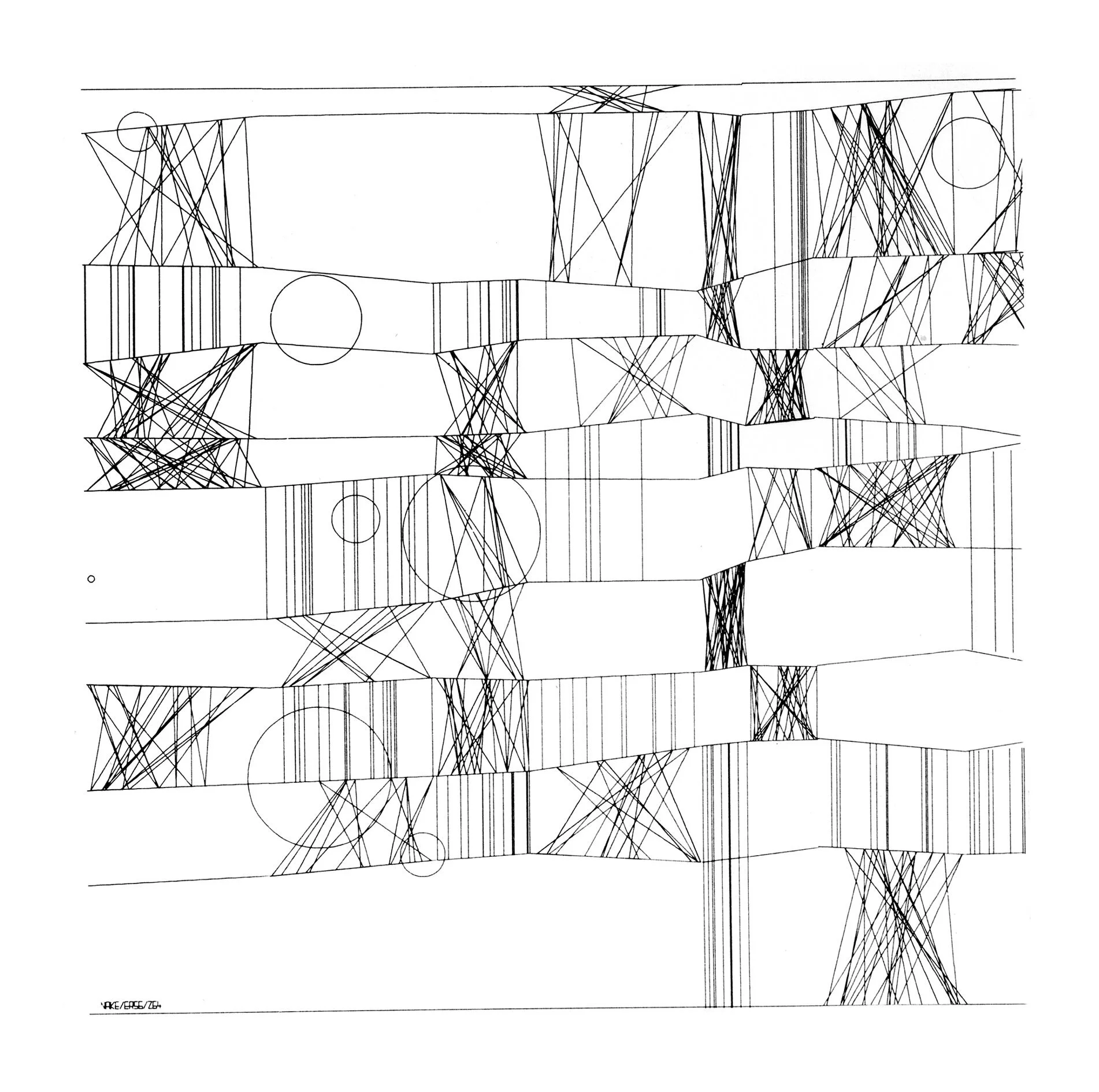























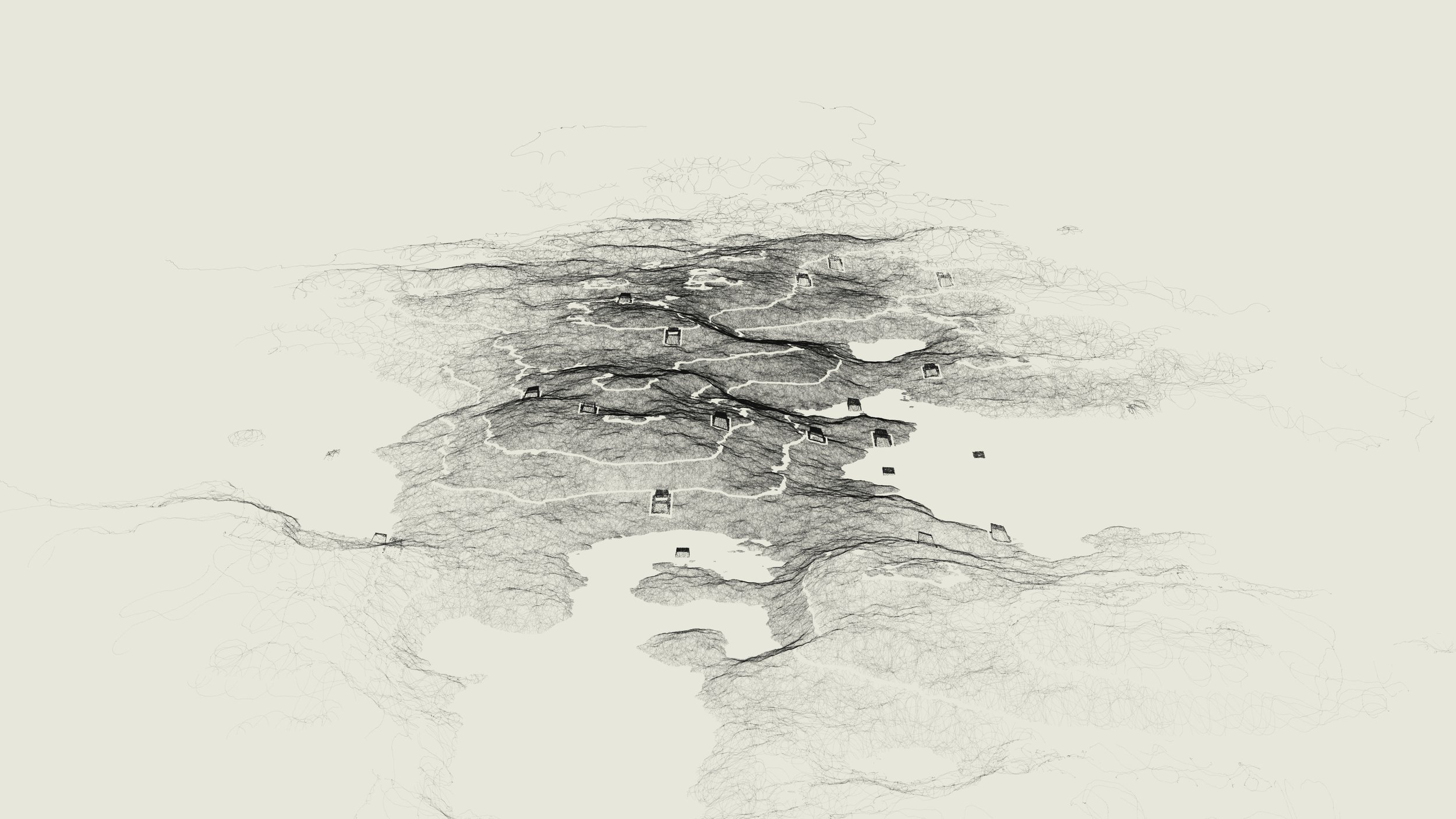



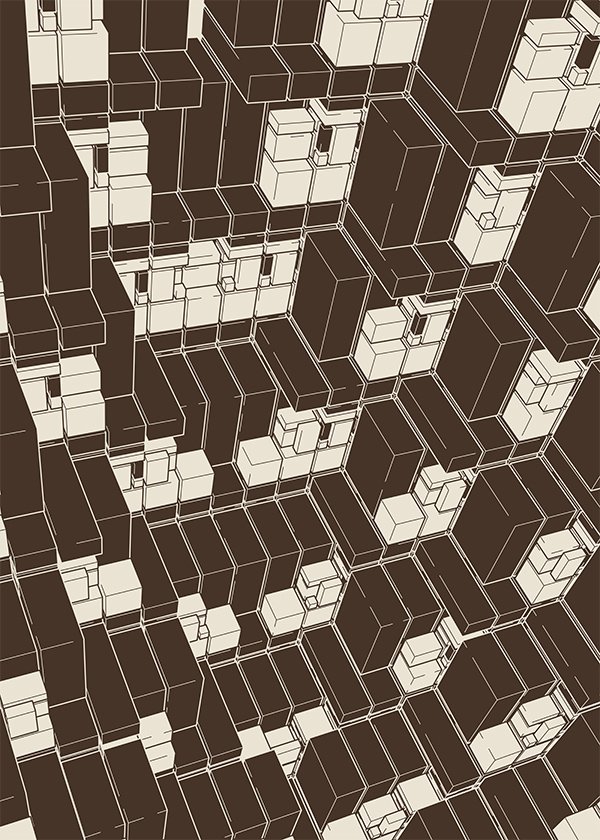

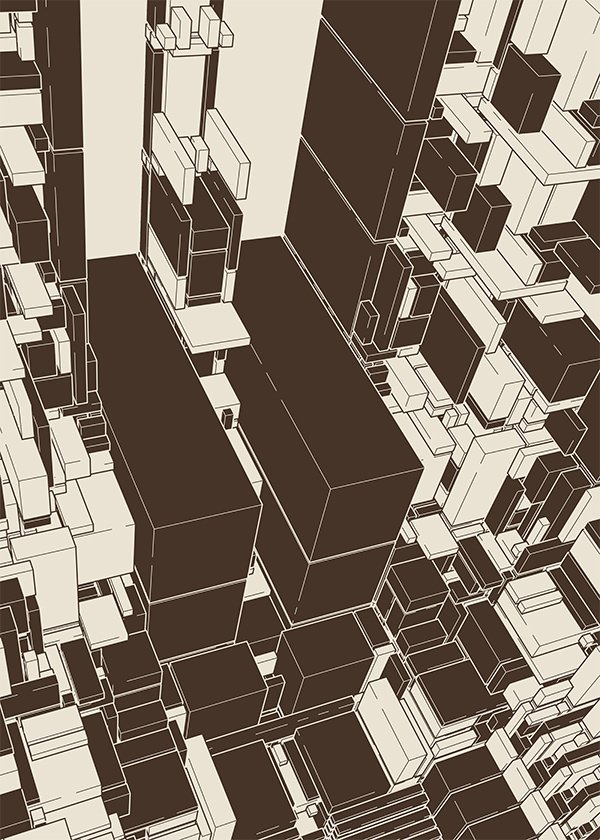
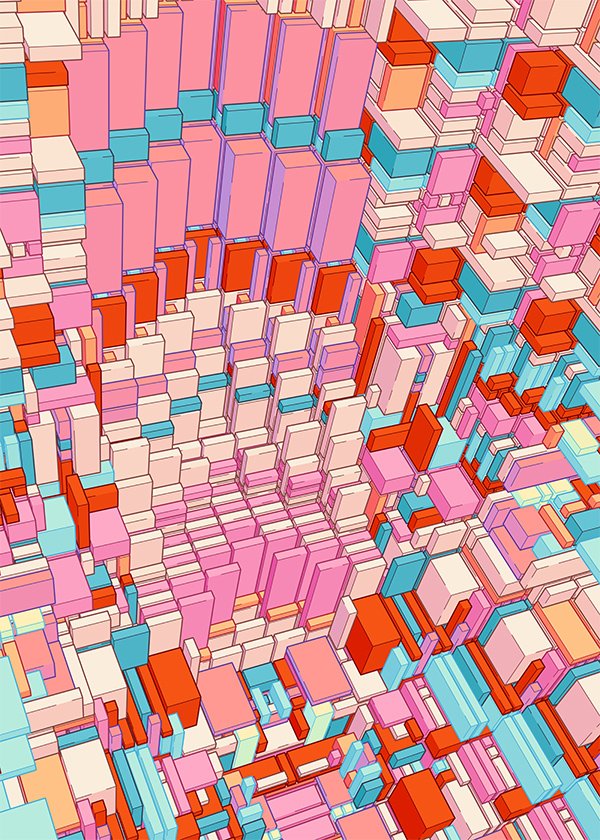

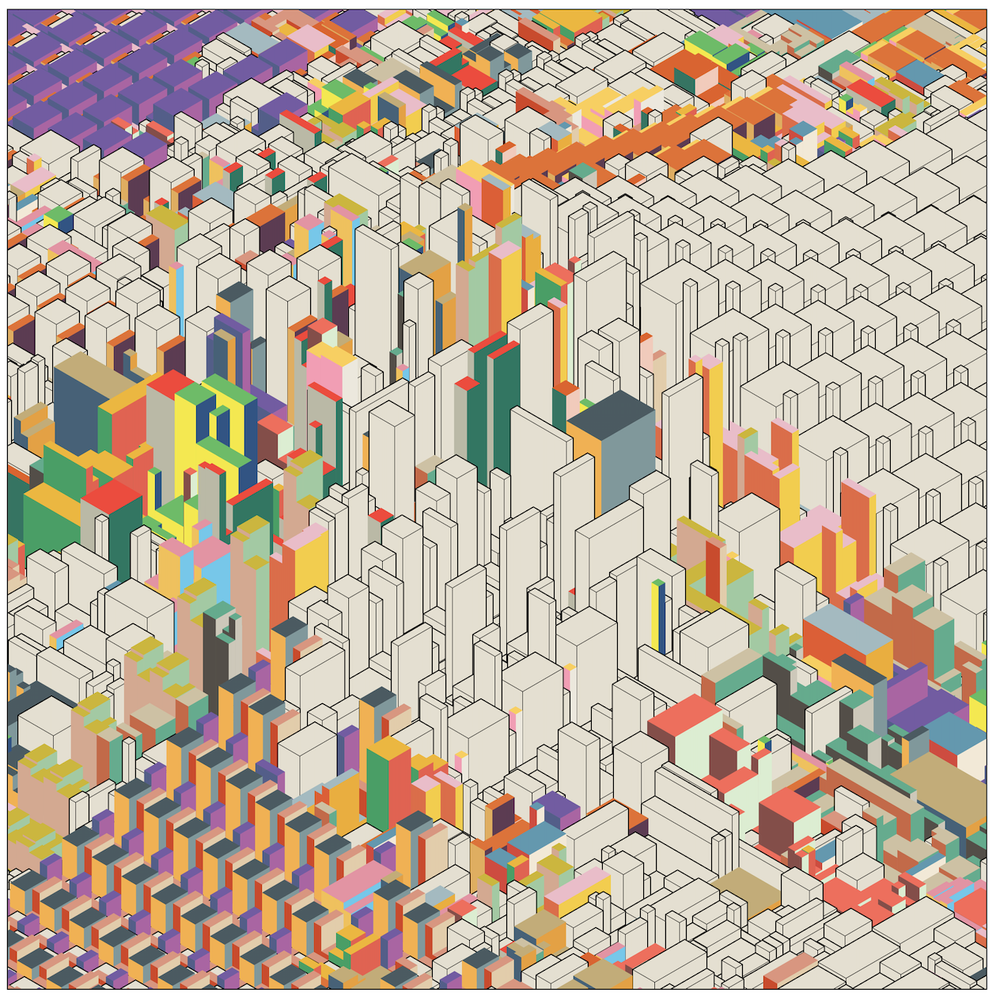








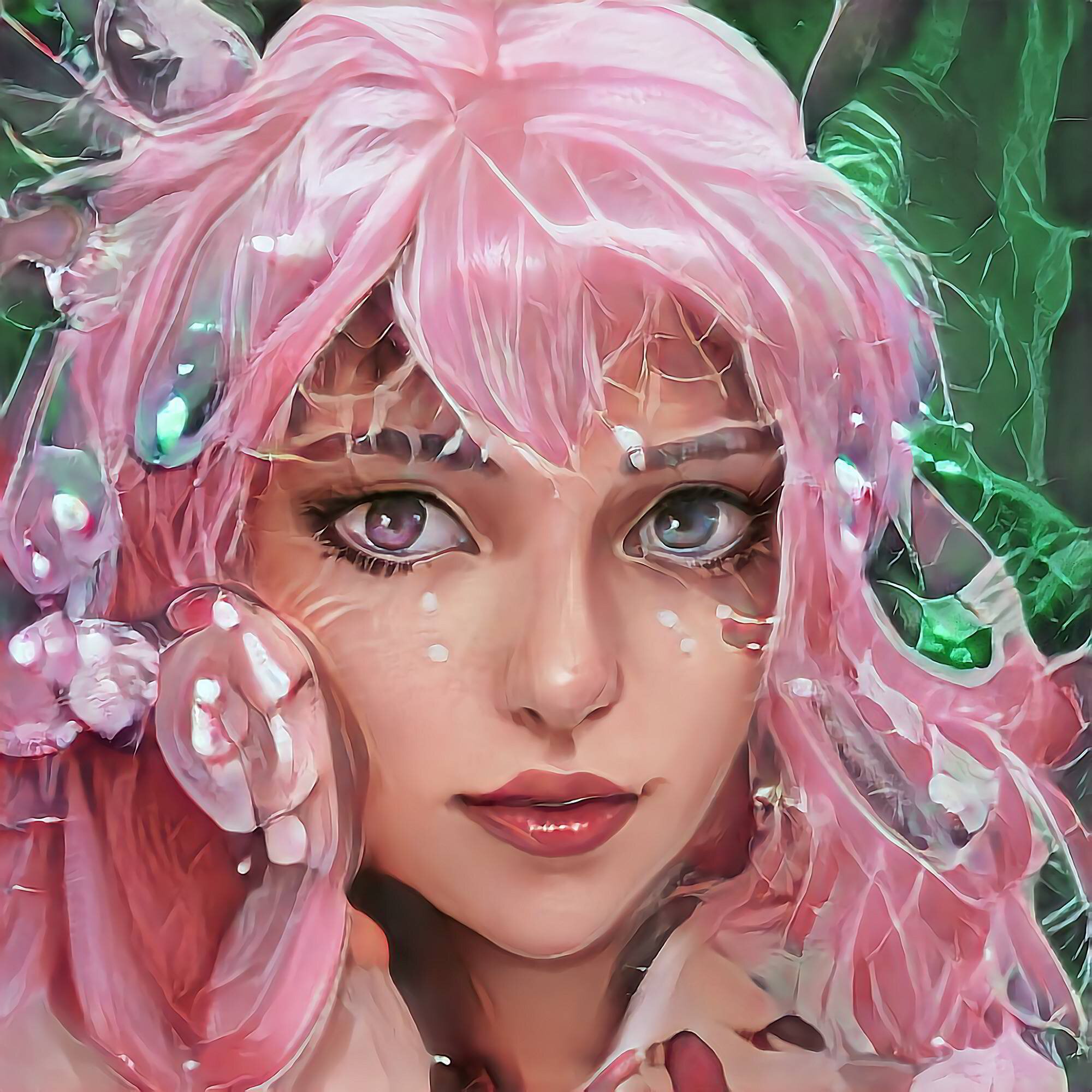




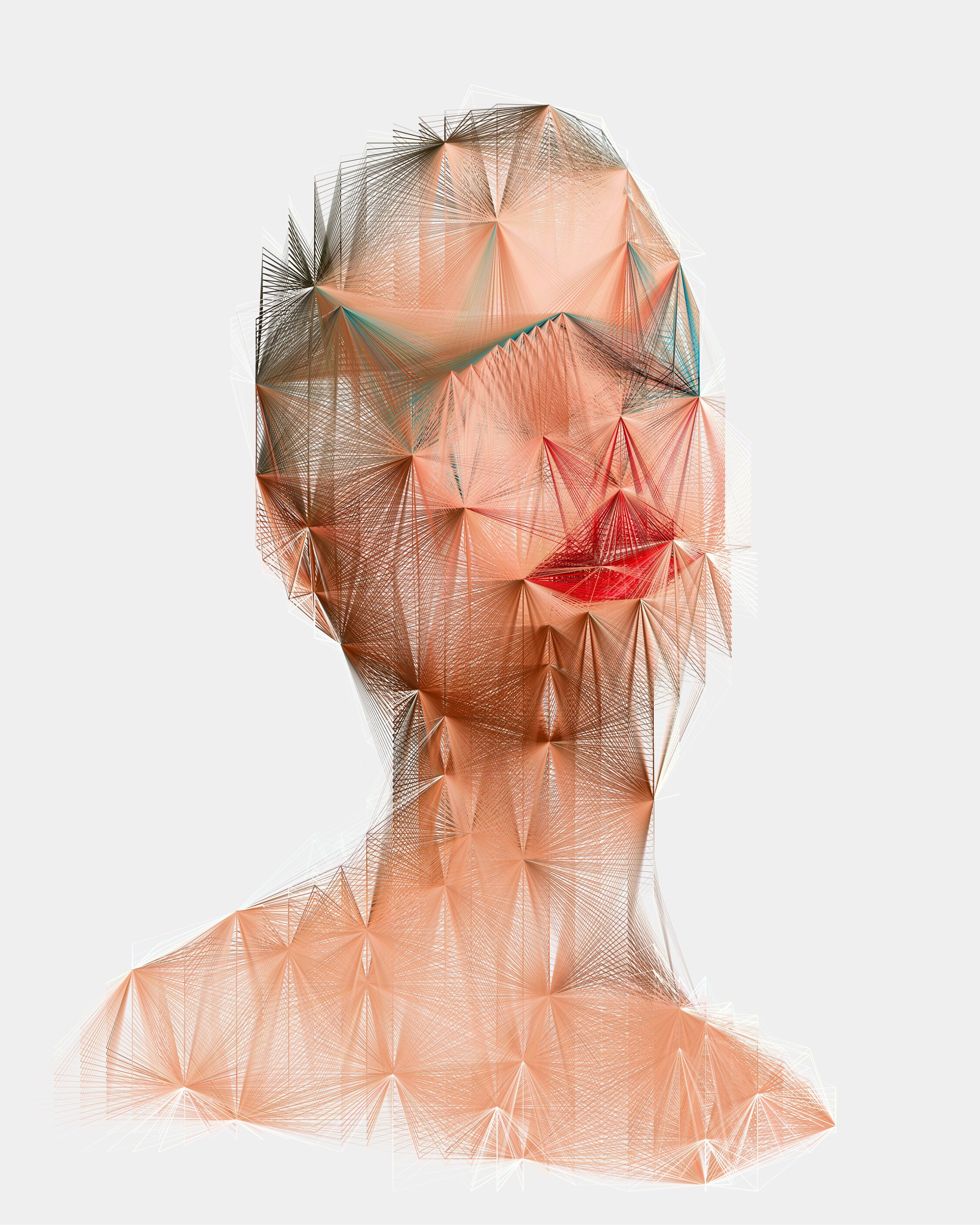









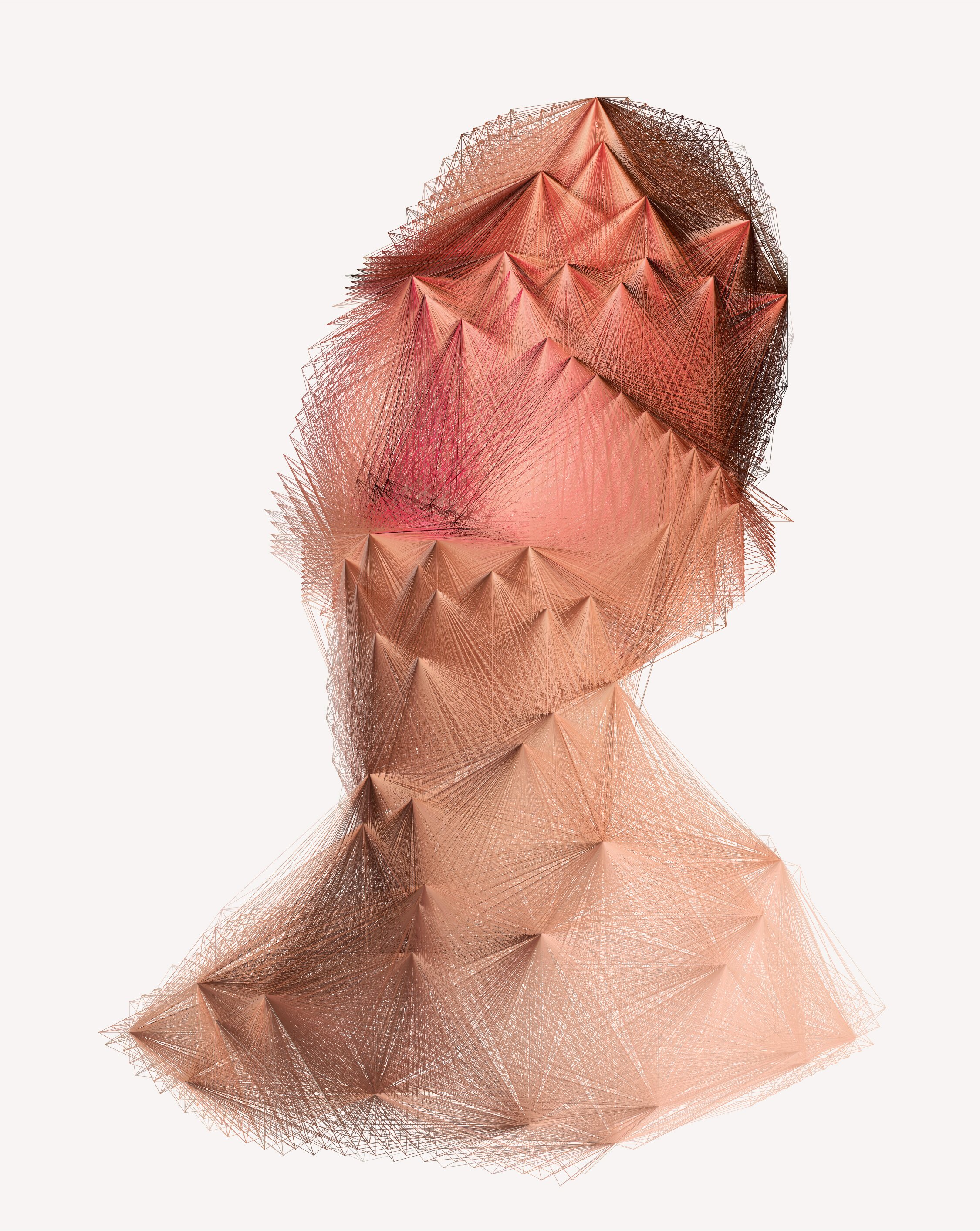








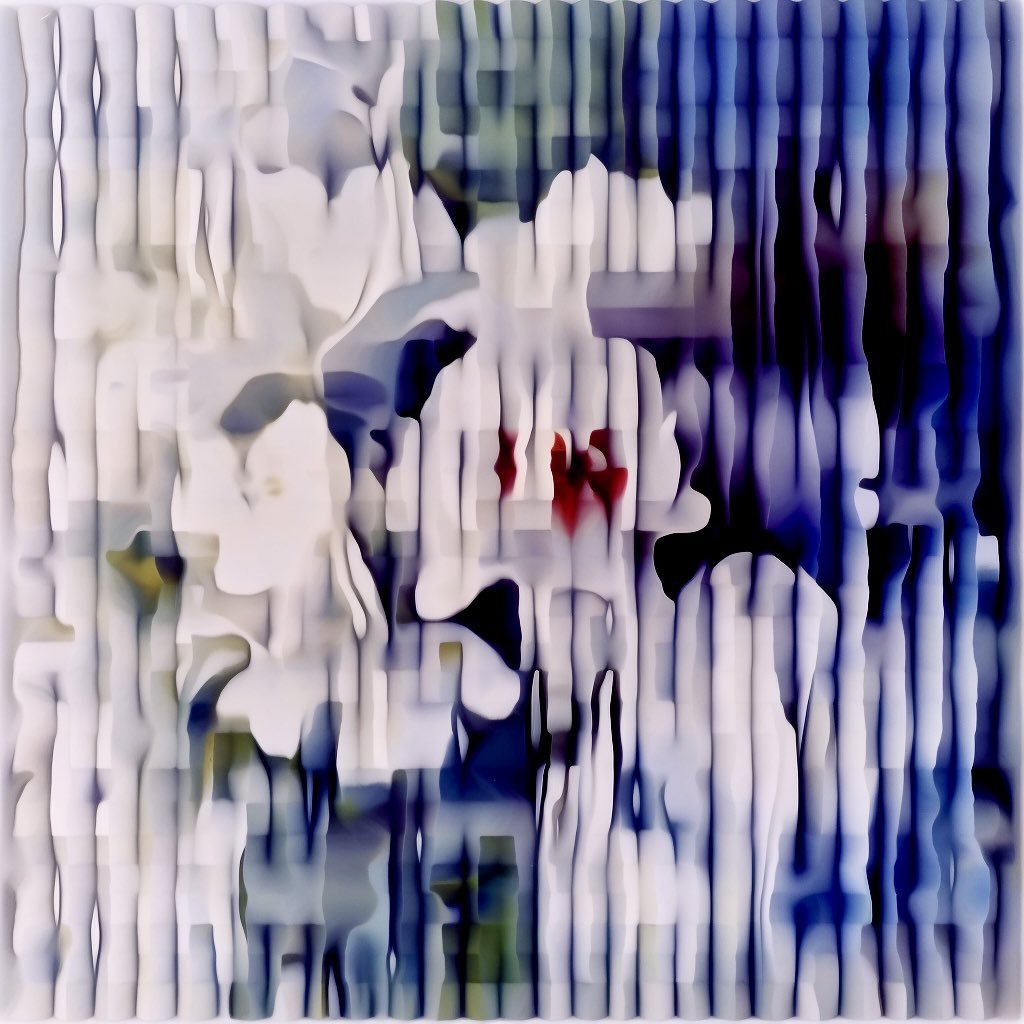
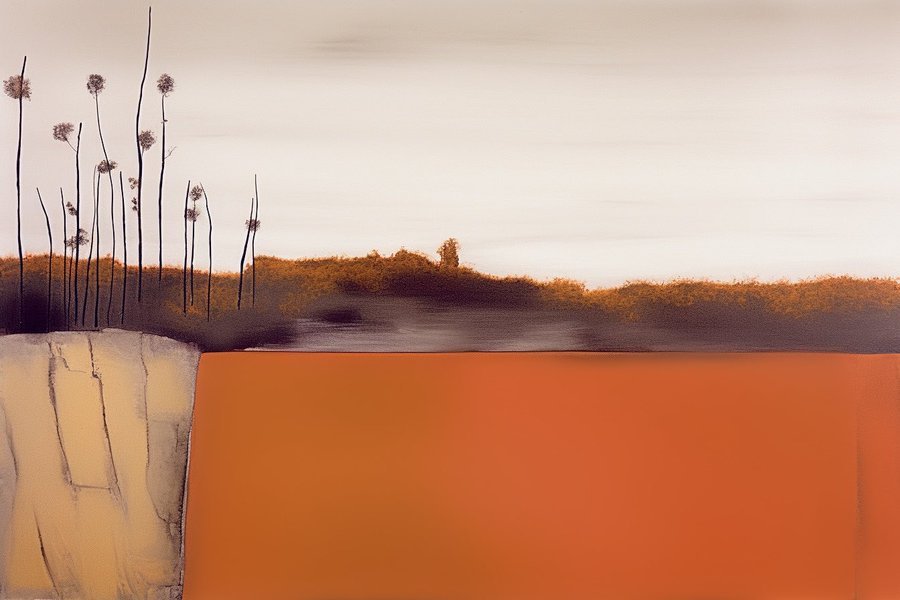
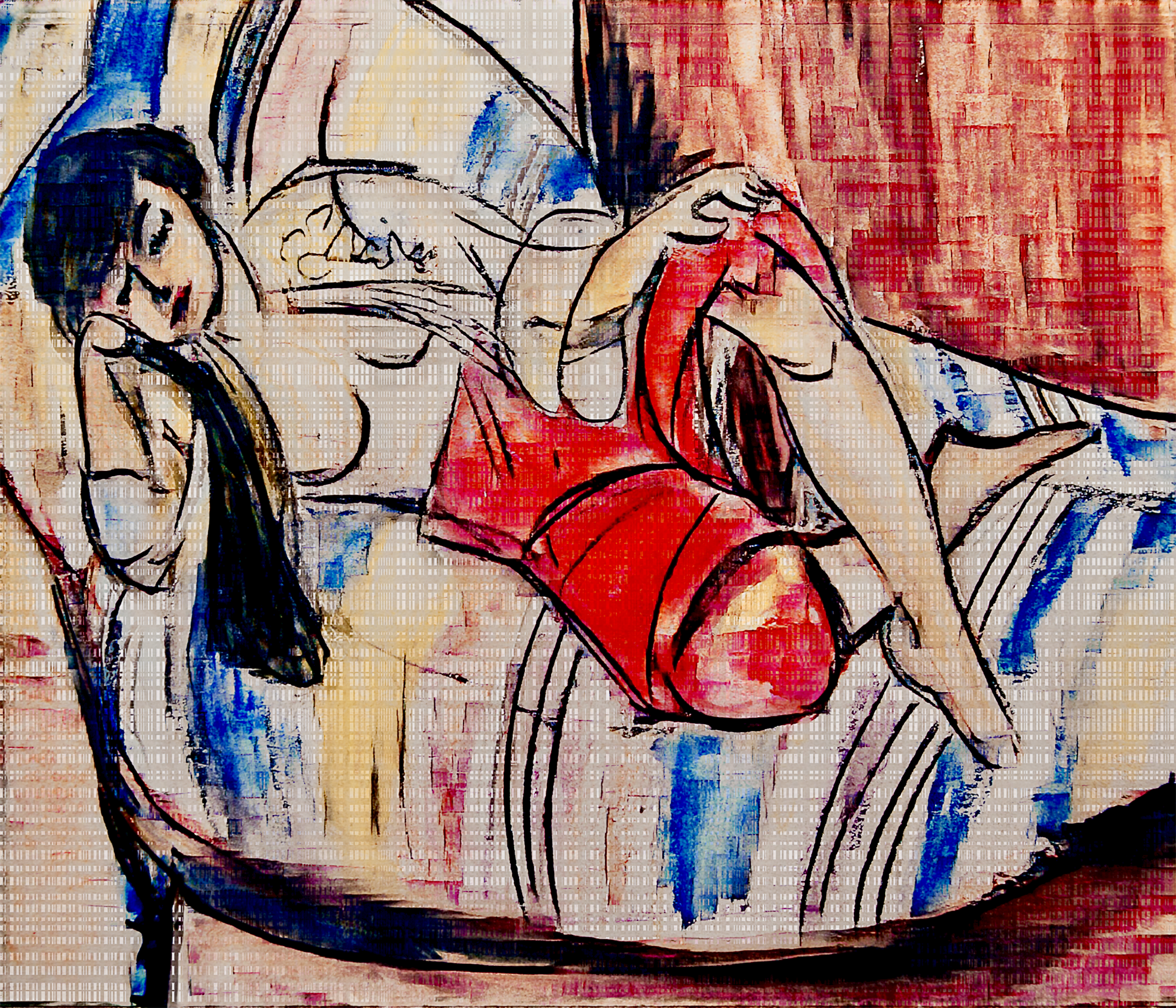



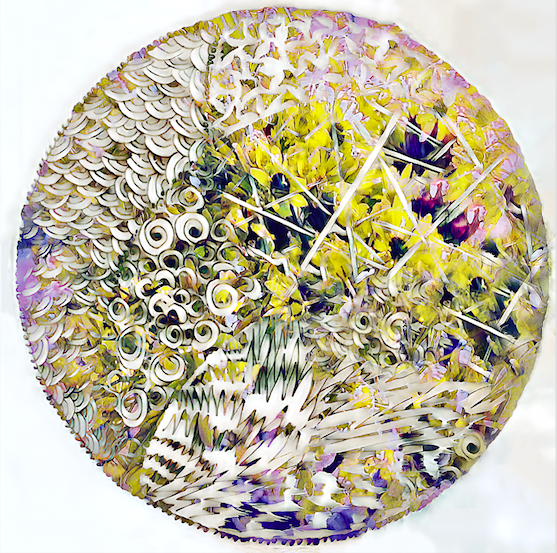


























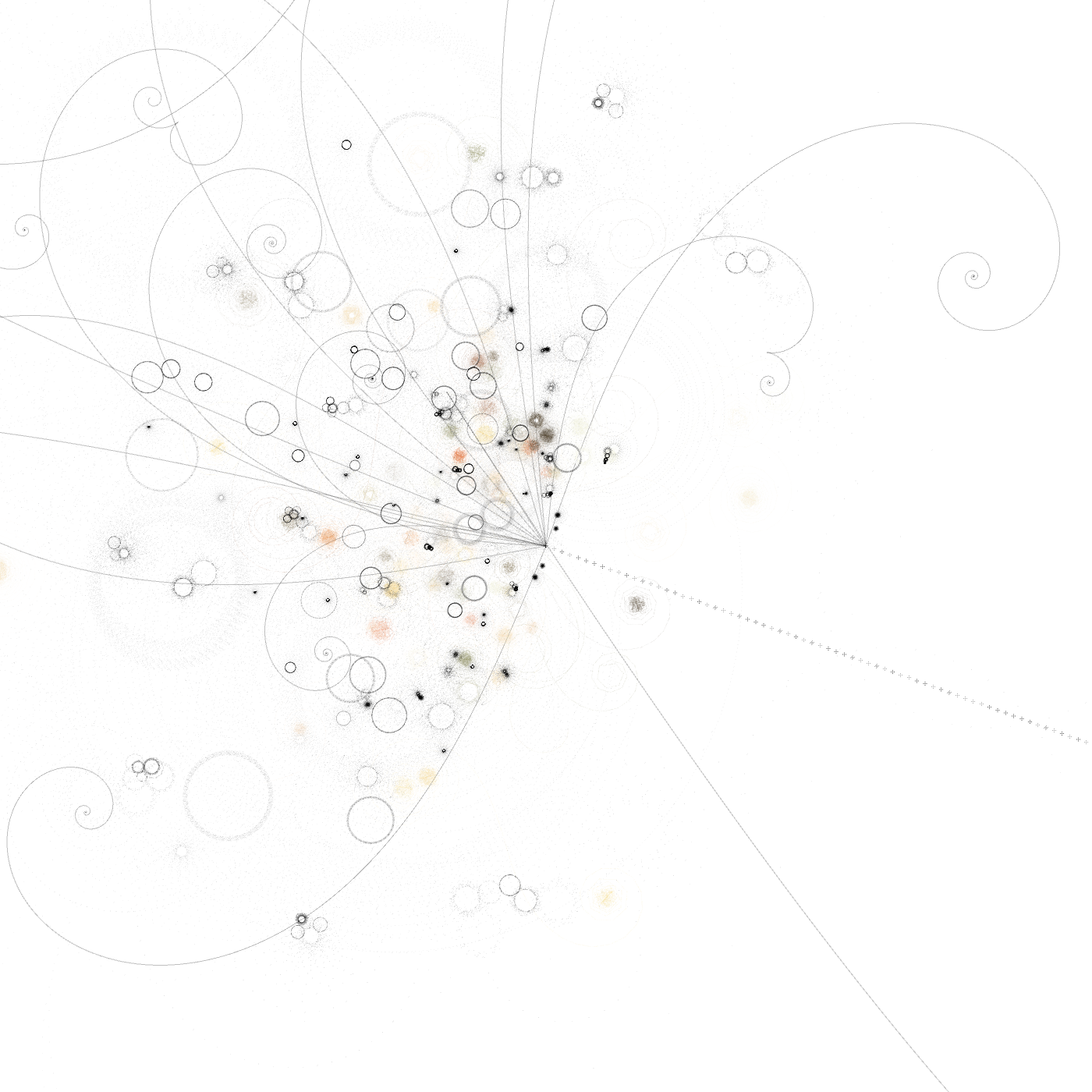


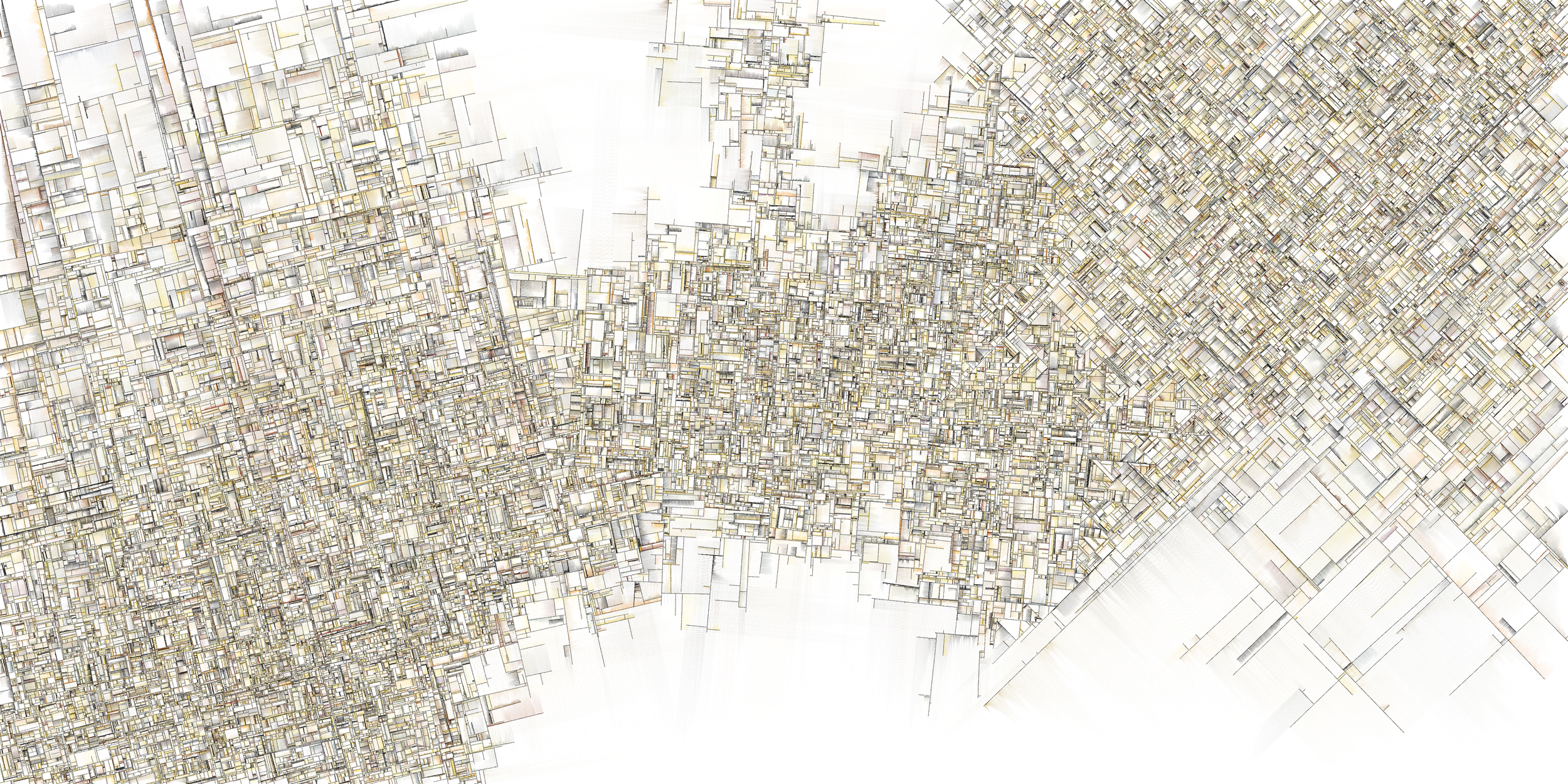
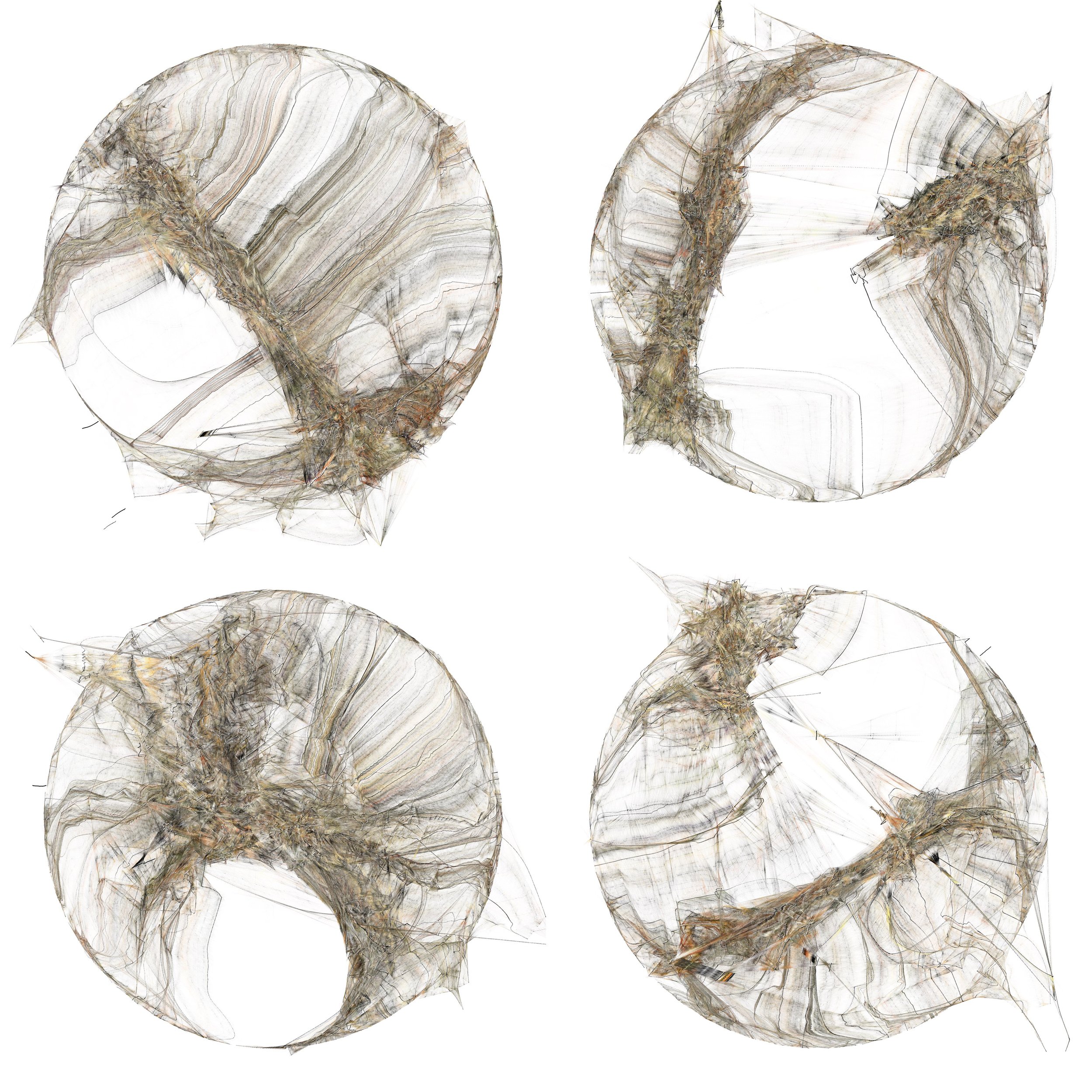




































World-renowned visual artist Kevin Abosch has created 100 physical artworks and a limited edition of 10 million virtual artworks entitled IAMA Coin.
The physical works are stamped using the artist's own blood, with the contract address on the Ethereum blockchain corresponding to the creation of the the 10 million virtual works. The virtual works are standard ERC-20 tokens and token owners are free to share these artworks and even divide them into smaller pieces before sharing.
From time to time Abosch will make various physical artworks available to collectors of IAMA coin virtual works. Therefore, aside from their intrinisc value, they may be utilized as a means to trade, in various quantities, for certain physical works as the artist's studio permits.